Japanese nihonga painting Stock Photos and Images
(82)See japanese nihonga painting stock video clipsQuick filters:
Japanese nihonga painting Stock Photos and Images
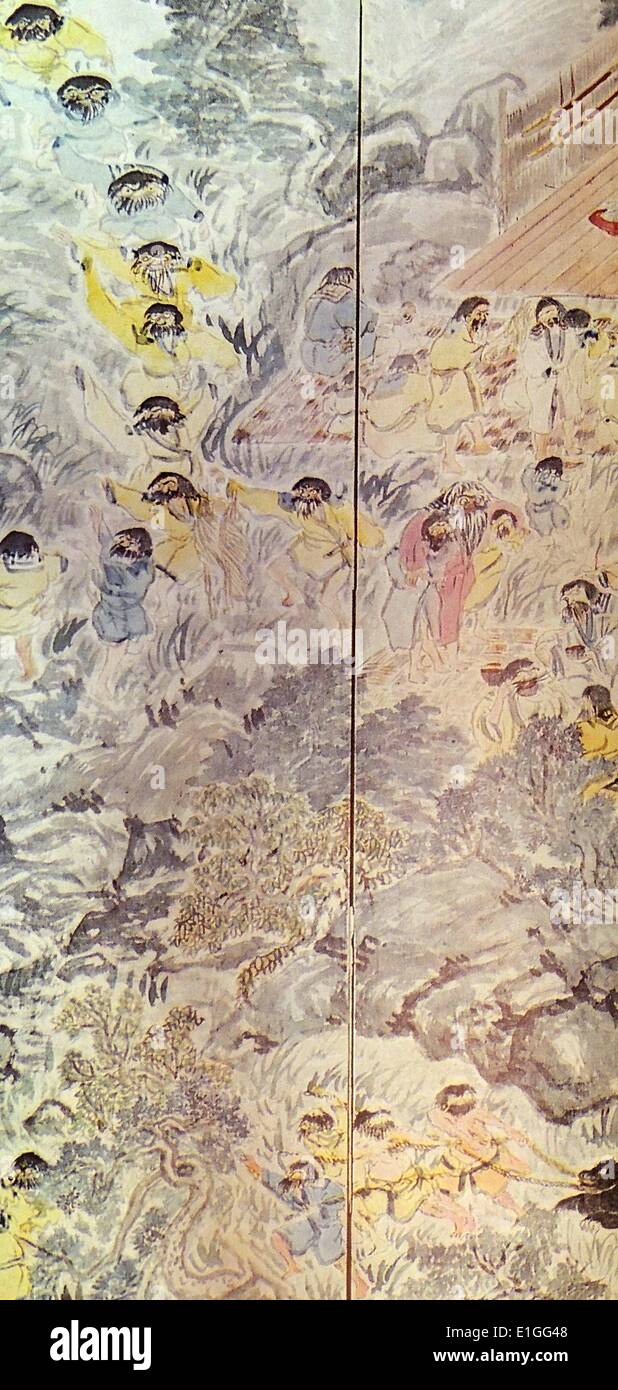 The large painting depicts different scenes of everyday life within an Ainu Village. By Tomioka Tessai (1837 - 1924) Japanese painter and Calligrapher in imperial Japan and one the first major artists of the Nihonga style. Dated 1870 Stock Photohttps://www.alamy.com/image-license-details/?v=1https://www.alamy.com/the-large-painting-depicts-different-scenes-of-everyday-life-within-image69820024.html
The large painting depicts different scenes of everyday life within an Ainu Village. By Tomioka Tessai (1837 - 1924) Japanese painter and Calligrapher in imperial Japan and one the first major artists of the Nihonga style. Dated 1870 Stock Photohttps://www.alamy.com/image-license-details/?v=1https://www.alamy.com/the-large-painting-depicts-different-scenes-of-everyday-life-within-image69820024.htmlRME1GG48–The large painting depicts different scenes of everyday life within an Ainu Village. By Tomioka Tessai (1837 - 1924) Japanese painter and Calligrapher in imperial Japan and one the first major artists of the Nihonga style. Dated 1870
 Artist: Shiokawa Bunrin, Japanese, 1808–1877, Seven Fireflies in the Moonlight, mid-19th century, Hanging scroll, ink and color on silk, without mounting: 51 1/8 × 20 15/16 in. (129.8 × 53.2 cm), Shiokawa Bunrin was one of the leading painters of the Shijō school (Fourth Avenue school), in Kyoto, during the late Edo period and the early Meiji era. The Shijō school was an offshoot of the Maruyama school, which emphasized the importance of making sketches and preparatory drawings directly from nature. Both schools may be considered precursors to Japanese-style painting (Nihonga) Stock Photohttps://www.alamy.com/image-license-details/?v=1https://www.alamy.com/artist-shiokawa-bunrin-japanese-18081877-seven-fireflies-in-themoonlight-mid-19thcentury-hanging-scroll-ink-and-color-on-silk-without-mounting-51-18-20-1516-in-1298-532-cm-shiokawa-bunrin-was-one-of-the-leading-painters-of-the-shij-school-fourth-avenue-school-in-kyoto-during-the-late-edo-period-and-the-early-meiji-era-the-shij-school-was-an-offshoot-of-the-maruyama-school-which-emphasized-the-importance-of-making-sketches-and-preparatory-drawings-directly-from-nature-both-schools-may-be-considered-precursors-to-japanese-style-painting-nihonga-image393088341.html
Artist: Shiokawa Bunrin, Japanese, 1808–1877, Seven Fireflies in the Moonlight, mid-19th century, Hanging scroll, ink and color on silk, without mounting: 51 1/8 × 20 15/16 in. (129.8 × 53.2 cm), Shiokawa Bunrin was one of the leading painters of the Shijō school (Fourth Avenue school), in Kyoto, during the late Edo period and the early Meiji era. The Shijō school was an offshoot of the Maruyama school, which emphasized the importance of making sketches and preparatory drawings directly from nature. Both schools may be considered precursors to Japanese-style painting (Nihonga) Stock Photohttps://www.alamy.com/image-license-details/?v=1https://www.alamy.com/artist-shiokawa-bunrin-japanese-18081877-seven-fireflies-in-themoonlight-mid-19thcentury-hanging-scroll-ink-and-color-on-silk-without-mounting-51-18-20-1516-in-1298-532-cm-shiokawa-bunrin-was-one-of-the-leading-painters-of-the-shij-school-fourth-avenue-school-in-kyoto-during-the-late-edo-period-and-the-early-meiji-era-the-shij-school-was-an-offshoot-of-the-maruyama-school-which-emphasized-the-importance-of-making-sketches-and-preparatory-drawings-directly-from-nature-both-schools-may-be-considered-precursors-to-japanese-style-painting-nihonga-image393088341.htmlRM2DREM59–Artist: Shiokawa Bunrin, Japanese, 1808–1877, Seven Fireflies in the Moonlight, mid-19th century, Hanging scroll, ink and color on silk, without mounting: 51 1/8 × 20 15/16 in. (129.8 × 53.2 cm), Shiokawa Bunrin was one of the leading painters of the Shijō school (Fourth Avenue school), in Kyoto, during the late Edo period and the early Meiji era. The Shijō school was an offshoot of the Maruyama school, which emphasized the importance of making sketches and preparatory drawings directly from nature. Both schools may be considered precursors to Japanese-style painting (Nihonga)
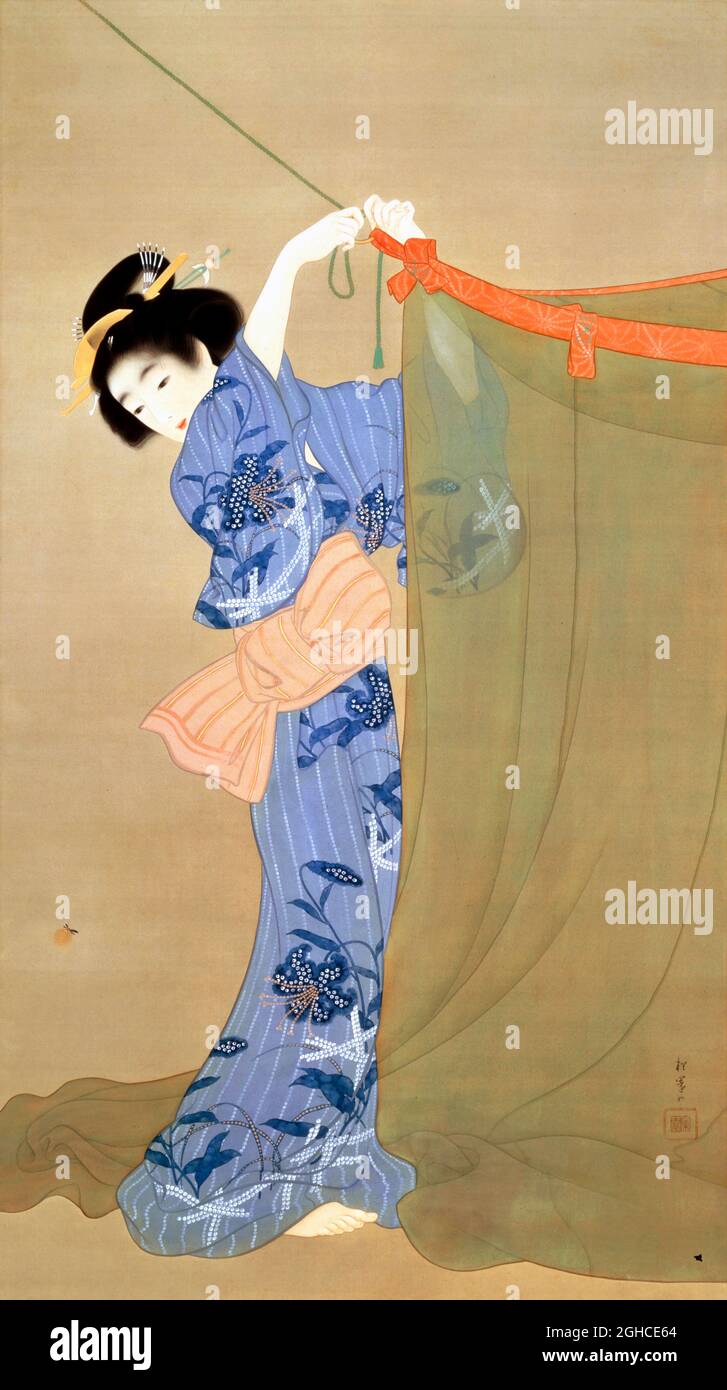 Firefly by the Japanese artist, Uemura Shōen (1875-1949), colour on silk, 1913 Stock Photohttps://www.alamy.com/image-license-details/?v=1https://www.alamy.com/firefly-by-the-japanese-artist-uemura-shen-1875-1949-colour-on-silk-1913-image440982924.html
Firefly by the Japanese artist, Uemura Shōen (1875-1949), colour on silk, 1913 Stock Photohttps://www.alamy.com/image-license-details/?v=1https://www.alamy.com/firefly-by-the-japanese-artist-uemura-shen-1875-1949-colour-on-silk-1913-image440982924.htmlRM2GHCE64–Firefly by the Japanese artist, Uemura Shōen (1875-1949), colour on silk, 1913
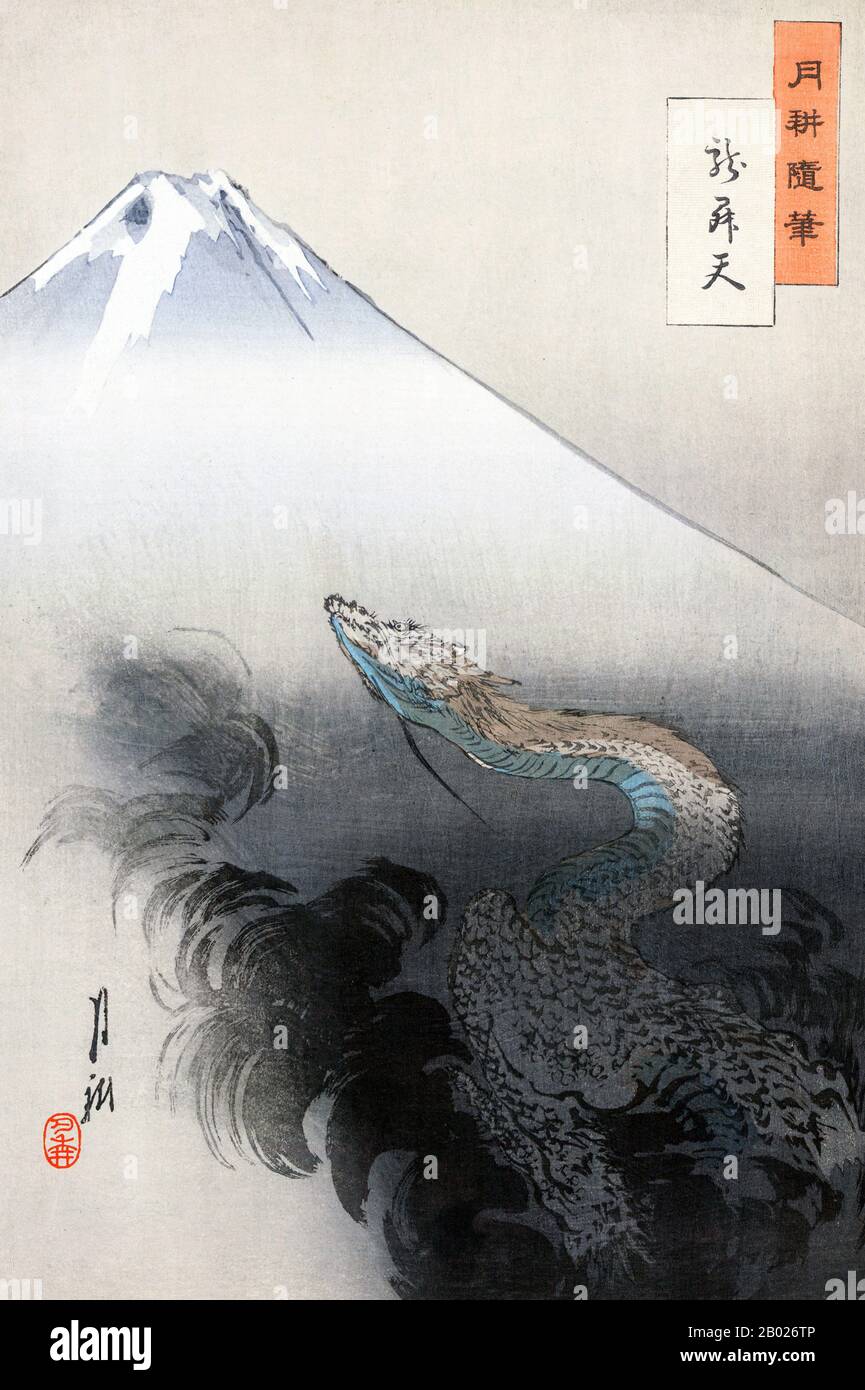 Ogata Gekkō (尾形月耕, 1859-1920) was a Japanese painter and woodblock print artist of the ukiyo-e genre. Gekkō's work was originally closely based upon that of Kikuchi Yōsai. He was inspired by Hokusai, creating a series of one hundred prints of Mount Fuji. He also developed his own style, with significant stylistic elements borrowed from nihonga painting. Stock Photohttps://www.alamy.com/image-license-details/?v=1https://www.alamy.com/ogata-gekk-1859-1920-was-a-japanese-painter-and-woodblock-print-artist-of-the-ukiyo-e-genre-gekks-work-was-originally-closely-based-upon-that-of-kikuchi-ysai-he-was-inspired-by-hokusai-creating-a-series-of-one-hundred-prints-of-mount-fuji-he-also-developed-his-own-style-with-significant-stylistic-elements-borrowed-from-nihonga-painting-image344256662.html
Ogata Gekkō (尾形月耕, 1859-1920) was a Japanese painter and woodblock print artist of the ukiyo-e genre. Gekkō's work was originally closely based upon that of Kikuchi Yōsai. He was inspired by Hokusai, creating a series of one hundred prints of Mount Fuji. He also developed his own style, with significant stylistic elements borrowed from nihonga painting. Stock Photohttps://www.alamy.com/image-license-details/?v=1https://www.alamy.com/ogata-gekk-1859-1920-was-a-japanese-painter-and-woodblock-print-artist-of-the-ukiyo-e-genre-gekks-work-was-originally-closely-based-upon-that-of-kikuchi-ysai-he-was-inspired-by-hokusai-creating-a-series-of-one-hundred-prints-of-mount-fuji-he-also-developed-his-own-style-with-significant-stylistic-elements-borrowed-from-nihonga-painting-image344256662.htmlRM2B026TP–Ogata Gekkō (尾形月耕, 1859-1920) was a Japanese painter and woodblock print artist of the ukiyo-e genre. Gekkō's work was originally closely based upon that of Kikuchi Yōsai. He was inspired by Hokusai, creating a series of one hundred prints of Mount Fuji. He also developed his own style, with significant stylistic elements borrowed from nihonga painting.
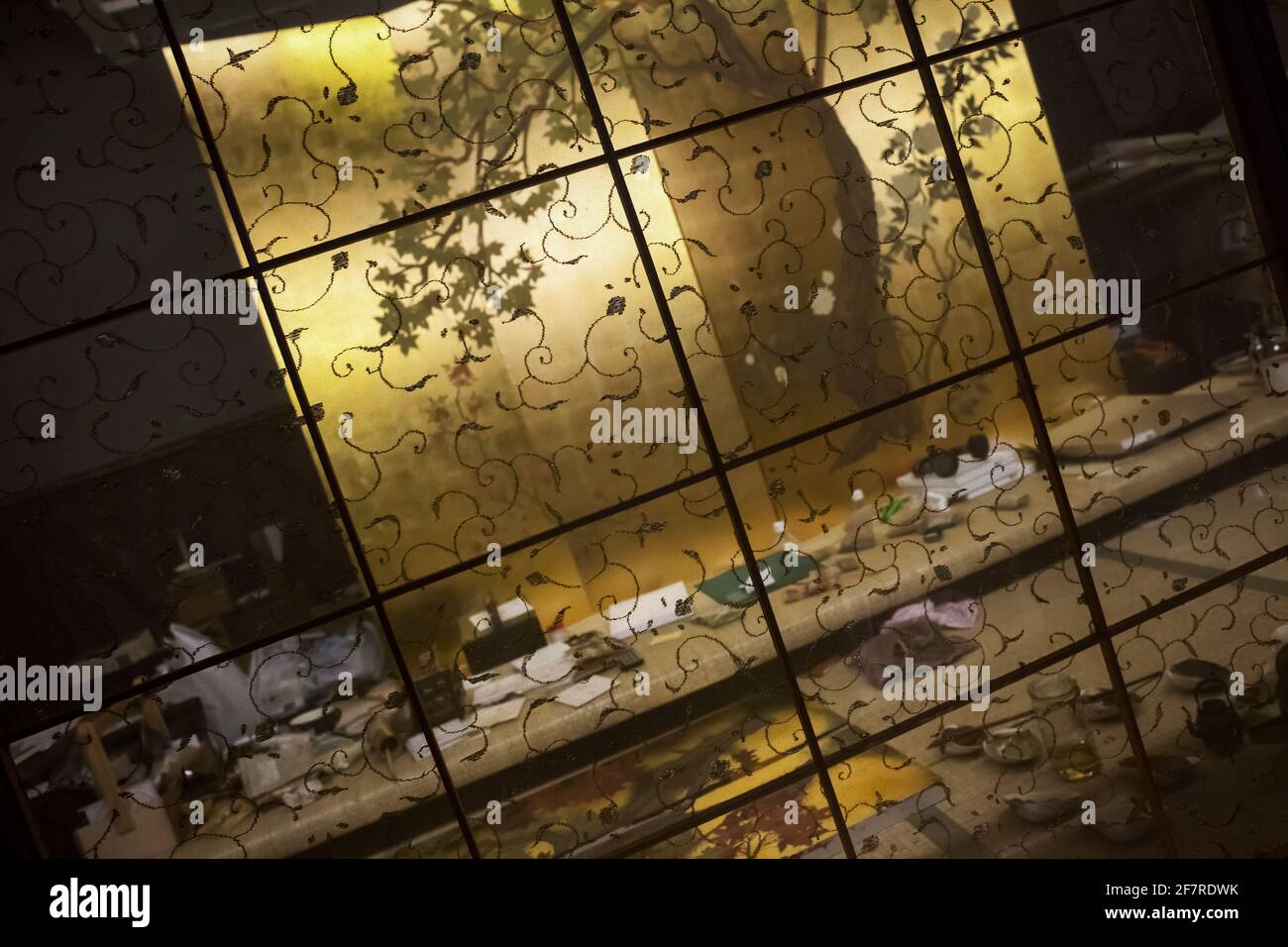 Slanted view of the Art Sanctuary Allan West (Allan West's studio and gallery of Nihonga (Japanese style painting)) interior in Yanaka, Taito City Stock Photohttps://www.alamy.com/image-license-details/?v=1https://www.alamy.com/slanted-view-of-the-art-sanctuary-allan-west-allan-wests-studio-and-gallery-of-nihonga-japanese-style-painting-interior-in-yanaka-taito-city-image417867231.html
Slanted view of the Art Sanctuary Allan West (Allan West's studio and gallery of Nihonga (Japanese style painting)) interior in Yanaka, Taito City Stock Photohttps://www.alamy.com/image-license-details/?v=1https://www.alamy.com/slanted-view-of-the-art-sanctuary-allan-west-allan-wests-studio-and-gallery-of-nihonga-japanese-style-painting-interior-in-yanaka-taito-city-image417867231.htmlRF2F7RDWK–Slanted view of the Art Sanctuary Allan West (Allan West's studio and gallery of Nihonga (Japanese style painting)) interior in Yanaka, Taito City
 Uemura Shōen (上村 松園, April 23, 1875 – August 27, 1949) was the pseudonym of an important woman artist in Meiji, Taishō and early Shōwa period Japanese painting. Her real name was Uemura Tsune. Shōen was known primarily for her bijinga paintings of beautiful women in the nihonga style, although she also produced numerous works on historical themes and traditional subjects. Stock Photohttps://www.alamy.com/image-license-details/?v=1https://www.alamy.com/uemura-shen-april-23-1875-august-27-1949-was-the-pseudonym-of-an-important-woman-artist-in-meiji-taish-and-early-shwa-period-japanese-painting-her-real-name-was-uemura-tsune-shen-was-known-primarily-for-her-bijinga-paintings-of-beautiful-women-in-the-nihonga-style-although-she-also-produced-numerous-works-on-historical-themes-and-traditional-subjects-image344264553.html
Uemura Shōen (上村 松園, April 23, 1875 – August 27, 1949) was the pseudonym of an important woman artist in Meiji, Taishō and early Shōwa period Japanese painting. Her real name was Uemura Tsune. Shōen was known primarily for her bijinga paintings of beautiful women in the nihonga style, although she also produced numerous works on historical themes and traditional subjects. Stock Photohttps://www.alamy.com/image-license-details/?v=1https://www.alamy.com/uemura-shen-april-23-1875-august-27-1949-was-the-pseudonym-of-an-important-woman-artist-in-meiji-taish-and-early-shwa-period-japanese-painting-her-real-name-was-uemura-tsune-shen-was-known-primarily-for-her-bijinga-paintings-of-beautiful-women-in-the-nihonga-style-although-she-also-produced-numerous-works-on-historical-themes-and-traditional-subjects-image344264553.htmlRM2B02GXH–Uemura Shōen (上村 松園, April 23, 1875 – August 27, 1949) was the pseudonym of an important woman artist in Meiji, Taishō and early Shōwa period Japanese painting. Her real name was Uemura Tsune. Shōen was known primarily for her bijinga paintings of beautiful women in the nihonga style, although she also produced numerous works on historical themes and traditional subjects.
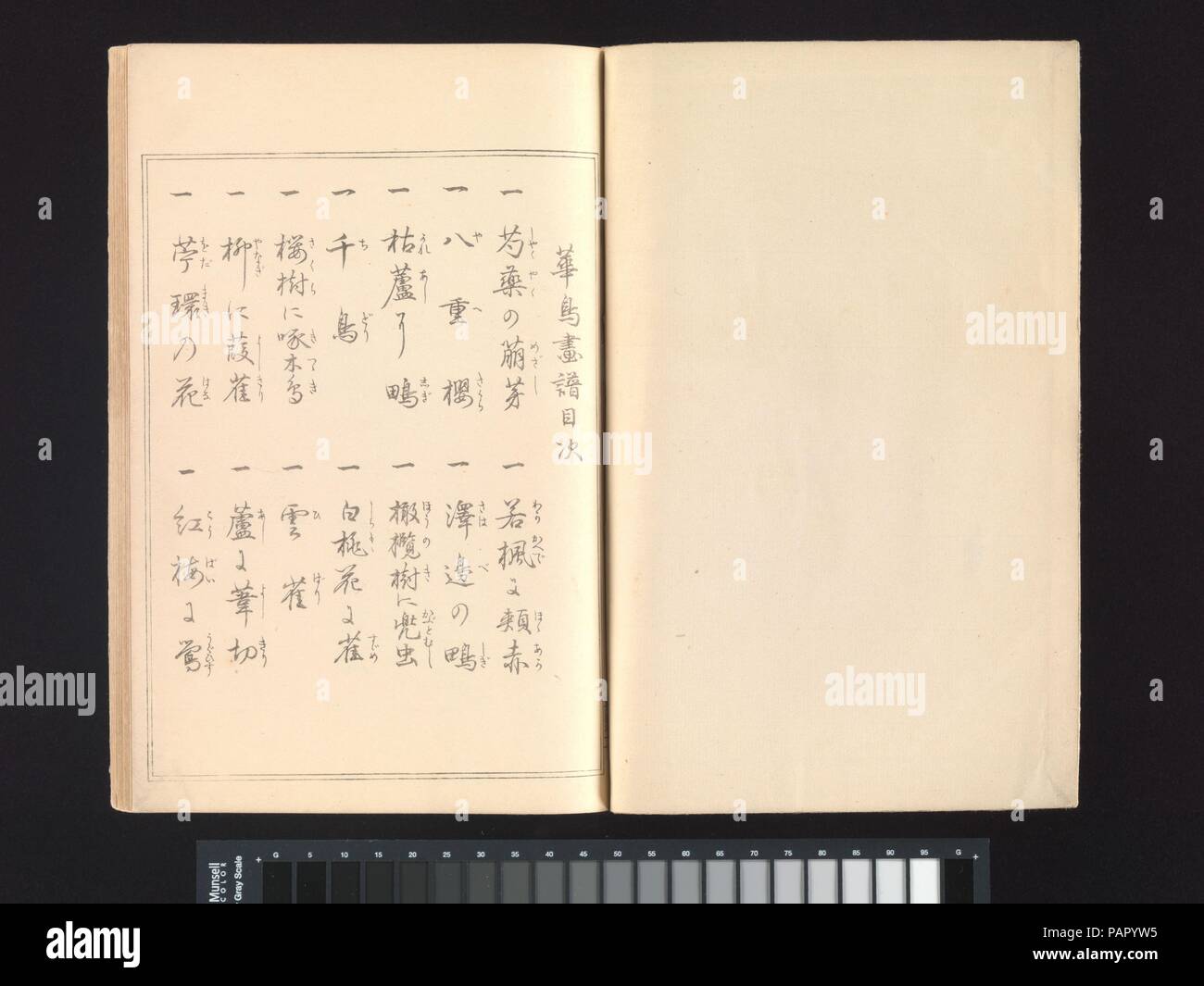 Seitei's Birds and Flowers Painting Manual (Seitei kacho gafu). Artist: Watanabe Seitei (Japanese, 1851-1918). Culture: Japan. Dimensions: 9 5/8 × 6 11/16 in. (24.5 × 17 cm). Date: 1891. Watanabe Seitei is Meiji painter, print artist and book illustrator famous for his naturalistic pictures of fauna and flora in the Nihonga style. We earlier acquired a copy of this book through the bequest of Lincoln Kirstein, though this example is in better condition, so it would be good to upgrade so that we have a displayable version. Museum: Metropolitan Museum of Art, New York, USA. Stock Photohttps://www.alamy.com/image-license-details/?v=1https://www.alamy.com/seiteis-birds-and-flowers-painting-manual-seitei-kacho-gafu-artist-watanabe-seitei-japanese-1851-1918-culture-japan-dimensions-9-58-6-1116-in-245-17-cm-date-1891-watanabe-seitei-is-meiji-painter-print-artist-and-book-illustrator-famous-for-his-naturalistic-pictures-of-fauna-and-flora-in-the-nihonga-style-we-earlier-acquired-a-copy-of-this-book-through-the-bequest-of-lincoln-kirstein-though-this-example-is-in-better-condition-so-it-would-be-good-to-upgrade-so-that-we-have-a-displayable-version-museum-metropolitan-museum-of-art-new-york-usa-image213175793.html
Seitei's Birds and Flowers Painting Manual (Seitei kacho gafu). Artist: Watanabe Seitei (Japanese, 1851-1918). Culture: Japan. Dimensions: 9 5/8 × 6 11/16 in. (24.5 × 17 cm). Date: 1891. Watanabe Seitei is Meiji painter, print artist and book illustrator famous for his naturalistic pictures of fauna and flora in the Nihonga style. We earlier acquired a copy of this book through the bequest of Lincoln Kirstein, though this example is in better condition, so it would be good to upgrade so that we have a displayable version. Museum: Metropolitan Museum of Art, New York, USA. Stock Photohttps://www.alamy.com/image-license-details/?v=1https://www.alamy.com/seiteis-birds-and-flowers-painting-manual-seitei-kacho-gafu-artist-watanabe-seitei-japanese-1851-1918-culture-japan-dimensions-9-58-6-1116-in-245-17-cm-date-1891-watanabe-seitei-is-meiji-painter-print-artist-and-book-illustrator-famous-for-his-naturalistic-pictures-of-fauna-and-flora-in-the-nihonga-style-we-earlier-acquired-a-copy-of-this-book-through-the-bequest-of-lincoln-kirstein-though-this-example-is-in-better-condition-so-it-would-be-good-to-upgrade-so-that-we-have-a-displayable-version-museum-metropolitan-museum-of-art-new-york-usa-image213175793.htmlRMPAPYW5–Seitei's Birds and Flowers Painting Manual (Seitei kacho gafu). Artist: Watanabe Seitei (Japanese, 1851-1918). Culture: Japan. Dimensions: 9 5/8 × 6 11/16 in. (24.5 × 17 cm). Date: 1891. Watanabe Seitei is Meiji painter, print artist and book illustrator famous for his naturalistic pictures of fauna and flora in the Nihonga style. We earlier acquired a copy of this book through the bequest of Lincoln Kirstein, though this example is in better condition, so it would be good to upgrade so that we have a displayable version. Museum: Metropolitan Museum of Art, New York, USA.
 Dragon painting. Senso-ji temple, Asakusa Stock Photohttps://www.alamy.com/image-license-details/?v=1https://www.alamy.com/stock-photo-dragon-painting-senso-ji-temple-asakusa-59343617.html
Dragon painting. Senso-ji temple, Asakusa Stock Photohttps://www.alamy.com/image-license-details/?v=1https://www.alamy.com/stock-photo-dragon-painting-senso-ji-temple-asakusa-59343617.htmlRMDCF9AW–Dragon painting. Senso-ji temple, Asakusa
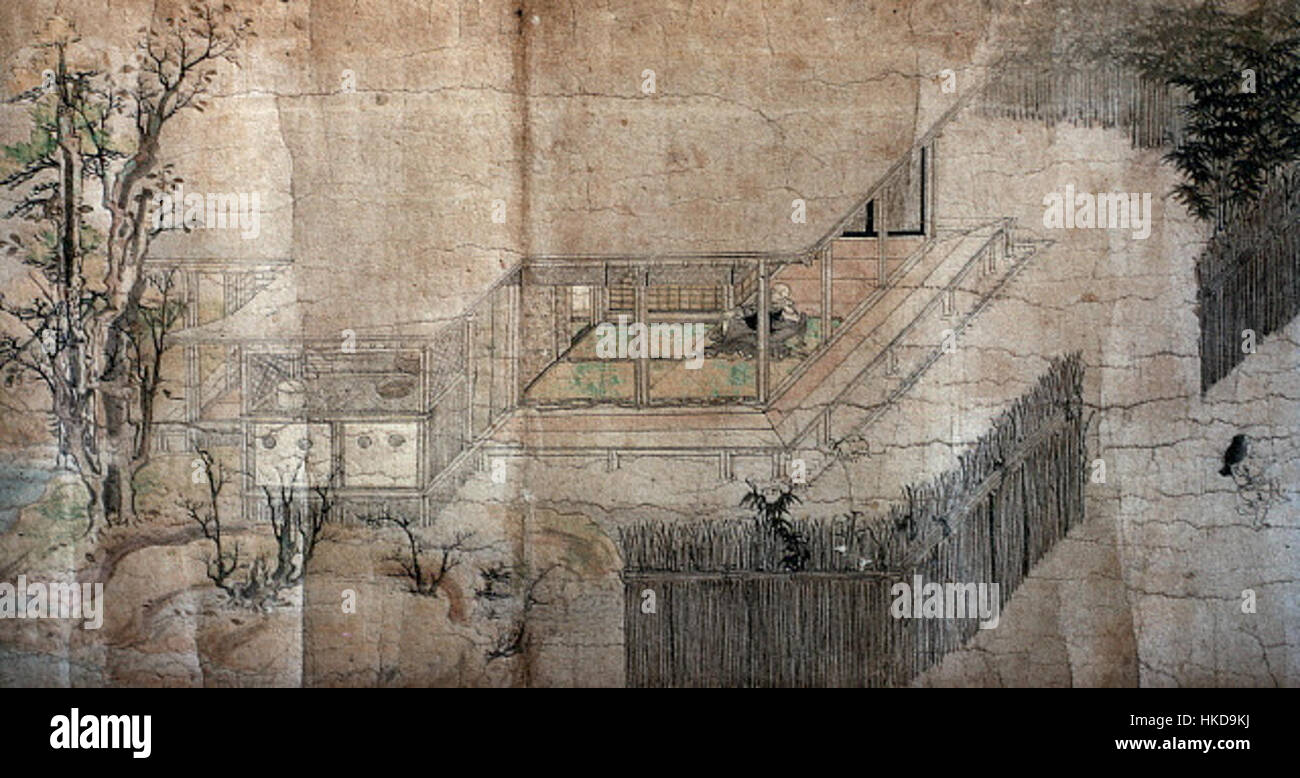 Saigyo Monogatari Emaki Tsunetaka Saigyo in meditation Stock Photohttps://www.alamy.com/image-license-details/?v=1https://www.alamy.com/stock-photo-saigyo-monogatari-emaki-tsunetaka-saigyo-in-meditation-132444022.html
Saigyo Monogatari Emaki Tsunetaka Saigyo in meditation Stock Photohttps://www.alamy.com/image-license-details/?v=1https://www.alamy.com/stock-photo-saigyo-monogatari-emaki-tsunetaka-saigyo-in-meditation-132444022.htmlRMHKD9KJ–Saigyo Monogatari Emaki Tsunetaka Saigyo in meditation
 Seven Beauties of the Bamboo Grove Watanabe Seitei ???? Japanese early 20th century Amidst a bamboo grove, seven women of different social status and walks of life—identifiable by their garments and hairstyles—are meticulously portrayed by Watanabe Seitei, a master of Nihonga, or “Japanese-style painting.” Though on the box lid inscribed by Seitei himself the work is referred to simply as “Seven Beauties” (Shichi bijin no zu ?????), the number of women and the setting immediately signal that this painting is a parodic representation of the age-old East Asian painting theme of Seven Sages of th Stock Photohttps://www.alamy.com/image-license-details/?v=1https://www.alamy.com/seven-beauties-of-the-bamboo-grove-watanabe-seitei-japanese-early-20th-century-amidst-a-bamboo-grove-seven-women-of-different-social-status-and-walks-of-lifeidentifiable-by-their-garments-and-hairstylesare-meticulously-portrayed-by-watanabe-seitei-a-master-of-nihonga-or-japanese-style-painting-though-on-the-box-lid-inscribed-by-seitei-himself-the-work-is-referred-to-simply-as-seven-beauties-shichi-bijin-no-zu-the-number-of-women-and-the-setting-immediately-signal-that-this-painting-is-a-parodic-representation-of-the-age-old-east-asian-painting-theme-of-seven-sages-of-th-image569501645.html
Seven Beauties of the Bamboo Grove Watanabe Seitei ???? Japanese early 20th century Amidst a bamboo grove, seven women of different social status and walks of life—identifiable by their garments and hairstyles—are meticulously portrayed by Watanabe Seitei, a master of Nihonga, or “Japanese-style painting.” Though on the box lid inscribed by Seitei himself the work is referred to simply as “Seven Beauties” (Shichi bijin no zu ?????), the number of women and the setting immediately signal that this painting is a parodic representation of the age-old East Asian painting theme of Seven Sages of th Stock Photohttps://www.alamy.com/image-license-details/?v=1https://www.alamy.com/seven-beauties-of-the-bamboo-grove-watanabe-seitei-japanese-early-20th-century-amidst-a-bamboo-grove-seven-women-of-different-social-status-and-walks-of-lifeidentifiable-by-their-garments-and-hairstylesare-meticulously-portrayed-by-watanabe-seitei-a-master-of-nihonga-or-japanese-style-painting-though-on-the-box-lid-inscribed-by-seitei-himself-the-work-is-referred-to-simply-as-seven-beauties-shichi-bijin-no-zu-the-number-of-women-and-the-setting-immediately-signal-that-this-painting-is-a-parodic-representation-of-the-age-old-east-asian-painting-theme-of-seven-sages-of-th-image569501645.htmlRM2T2F14D–Seven Beauties of the Bamboo Grove Watanabe Seitei ???? Japanese early 20th century Amidst a bamboo grove, seven women of different social status and walks of life—identifiable by their garments and hairstyles—are meticulously portrayed by Watanabe Seitei, a master of Nihonga, or “Japanese-style painting.” Though on the box lid inscribed by Seitei himself the work is referred to simply as “Seven Beauties” (Shichi bijin no zu ?????), the number of women and the setting immediately signal that this painting is a parodic representation of the age-old East Asian painting theme of Seven Sages of th
 Japan / England: 'Lady Reading Poetry'. Oil on canvas painting by Ishibashi Kazunori (1876-1928), 1906. Ishibashi Kazunori (1876-1928), also known as Stock Photohttps://www.alamy.com/image-license-details/?v=1https://www.alamy.com/japan-england-lady-reading-poetry-oil-on-canvas-painting-by-ishibashi-kazunori-1876-1928-1906-ishibashi-kazunori-1876-1928-also-known-as-image357258143.html
Japan / England: 'Lady Reading Poetry'. Oil on canvas painting by Ishibashi Kazunori (1876-1928), 1906. Ishibashi Kazunori (1876-1928), also known as Stock Photohttps://www.alamy.com/image-license-details/?v=1https://www.alamy.com/japan-england-lady-reading-poetry-oil-on-canvas-painting-by-ishibashi-kazunori-1876-1928-1906-ishibashi-kazunori-1876-1928-also-known-as-image357258143.htmlRM2BN6EBB–Japan / England: 'Lady Reading Poetry'. Oil on canvas painting by Ishibashi Kazunori (1876-1928), 1906. Ishibashi Kazunori (1876-1928), also known as
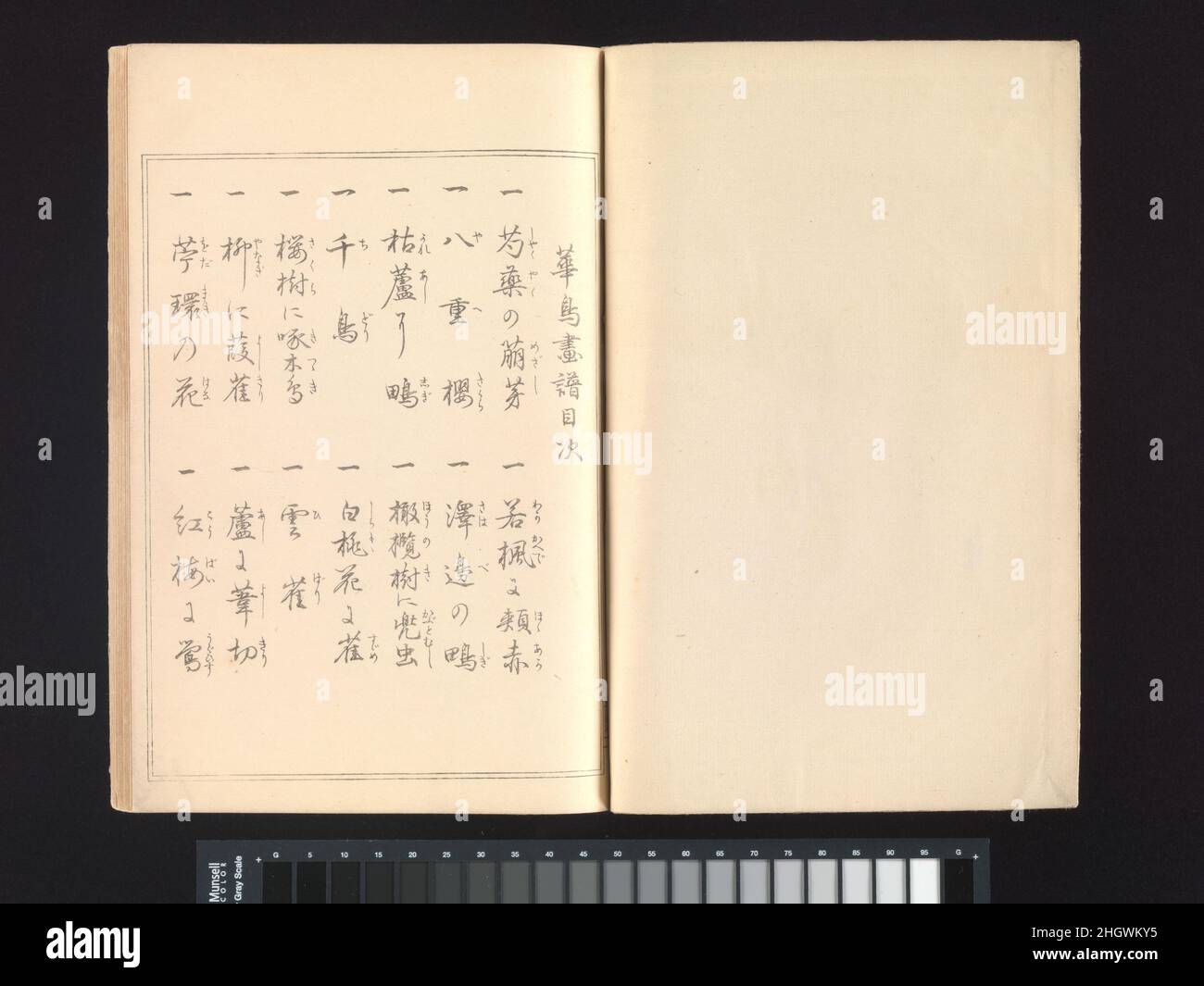 Seitei’s Birds and Flowers Painting Manual 1891 Watanabe Seitei Watanabe Seitei is Meiji painter, print artist and book illustrator famous for his naturalistic pictures of fauna and flora in the Nihonga style. We earlier acquired a copy of this book through the bequest of Lincoln Kirstein, though this example is in better condition, so it would be good to upgrade so that we have a displayable version.. Seitei’s Birds and Flowers Painting Manual. Watanabe Seitei (Japanese, 1851–1918). Japan. 1891. Woodblock printed book (Japanese-style binding); ink and color on paper. Meiji period (1868–1912). Stock Photohttps://www.alamy.com/image-license-details/?v=1https://www.alamy.com/seiteis-birds-and-flowers-painting-manual-1891-watanabe-seitei-watanabe-seitei-is-meiji-painter-print-artist-and-book-illustrator-famous-for-his-naturalistic-pictures-of-fauna-and-flora-in-the-nihonga-style-we-earlier-acquired-a-copy-of-this-book-through-the-bequest-of-lincoln-kirstein-though-this-example-is-in-better-condition-so-it-would-be-good-to-upgrade-so-that-we-have-a-displayable-version-seiteis-birds-and-flowers-painting-manual-watanabe-seitei-japanese-18511918-japan-1891-woodblock-printed-book-japanese-style-binding-ink-and-color-on-paper-meiji-period-18681912-image457868521.html
Seitei’s Birds and Flowers Painting Manual 1891 Watanabe Seitei Watanabe Seitei is Meiji painter, print artist and book illustrator famous for his naturalistic pictures of fauna and flora in the Nihonga style. We earlier acquired a copy of this book through the bequest of Lincoln Kirstein, though this example is in better condition, so it would be good to upgrade so that we have a displayable version.. Seitei’s Birds and Flowers Painting Manual. Watanabe Seitei (Japanese, 1851–1918). Japan. 1891. Woodblock printed book (Japanese-style binding); ink and color on paper. Meiji period (1868–1912). Stock Photohttps://www.alamy.com/image-license-details/?v=1https://www.alamy.com/seiteis-birds-and-flowers-painting-manual-1891-watanabe-seitei-watanabe-seitei-is-meiji-painter-print-artist-and-book-illustrator-famous-for-his-naturalistic-pictures-of-fauna-and-flora-in-the-nihonga-style-we-earlier-acquired-a-copy-of-this-book-through-the-bequest-of-lincoln-kirstein-though-this-example-is-in-better-condition-so-it-would-be-good-to-upgrade-so-that-we-have-a-displayable-version-seiteis-birds-and-flowers-painting-manual-watanabe-seitei-japanese-18511918-japan-1891-woodblock-printed-book-japanese-style-binding-ink-and-color-on-paper-meiji-period-18681912-image457868521.htmlRM2HGWKY5–Seitei’s Birds and Flowers Painting Manual 1891 Watanabe Seitei Watanabe Seitei is Meiji painter, print artist and book illustrator famous for his naturalistic pictures of fauna and flora in the Nihonga style. We earlier acquired a copy of this book through the bequest of Lincoln Kirstein, though this example is in better condition, so it would be good to upgrade so that we have a displayable version.. Seitei’s Birds and Flowers Painting Manual. Watanabe Seitei (Japanese, 1851–1918). Japan. 1891. Woodblock printed book (Japanese-style binding); ink and color on paper. Meiji period (1868–1912).
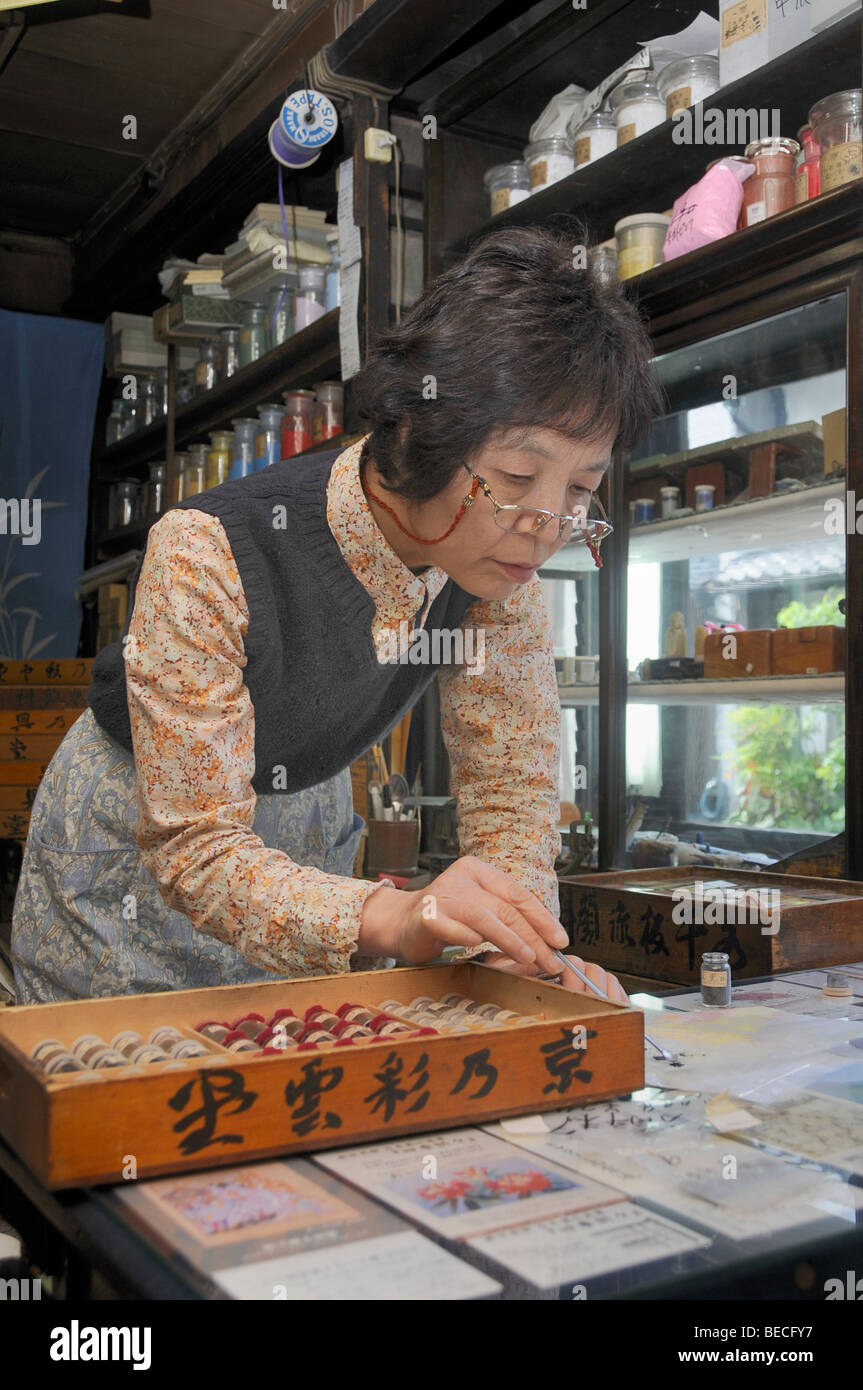 Sales clerk showing different mineral colours for Nihonga painting in a traditional shop for art supplies, Kyoto, Japan, Asia Stock Photohttps://www.alamy.com/image-license-details/?v=1https://www.alamy.com/stock-photo-sales-clerk-showing-different-mineral-colours-for-nihonga-painting-26091499.html
Sales clerk showing different mineral colours for Nihonga painting in a traditional shop for art supplies, Kyoto, Japan, Asia Stock Photohttps://www.alamy.com/image-license-details/?v=1https://www.alamy.com/stock-photo-sales-clerk-showing-different-mineral-colours-for-nihonga-painting-26091499.htmlRMBECFY7–Sales clerk showing different mineral colours for Nihonga painting in a traditional shop for art supplies, Kyoto, Japan, Asia
 JAPAN - CIRCA 1998: a stamp printed in the Japan shows Poppies, Painting by Kokei Kobayashi, Philately Week, circa 1998 Stock Photohttps://www.alamy.com/image-license-details/?v=1https://www.alamy.com/japan-circa-1998-a-stamp-printed-in-the-japan-shows-poppies-painting-by-kokei-kobayashi-philately-week-circa-1998-image443592056.html
JAPAN - CIRCA 1998: a stamp printed in the Japan shows Poppies, Painting by Kokei Kobayashi, Philately Week, circa 1998 Stock Photohttps://www.alamy.com/image-license-details/?v=1https://www.alamy.com/japan-circa-1998-a-stamp-printed-in-the-japan-shows-poppies-painting-by-kokei-kobayashi-philately-week-circa-1998-image443592056.htmlRF2GNKA5C–JAPAN - CIRCA 1998: a stamp printed in the Japan shows Poppies, Painting by Kokei Kobayashi, Philately Week, circa 1998
 Portrait of Taikan Yokoyama Stock Photohttps://www.alamy.com/image-license-details/?v=1https://www.alamy.com/stock-photo-portrait-of-taikan-yokoyama-120001563.html
Portrait of Taikan Yokoyama Stock Photohttps://www.alamy.com/image-license-details/?v=1https://www.alamy.com/stock-photo-portrait-of-taikan-yokoyama-120001563.htmlRMGY6F63–Portrait of Taikan Yokoyama
 Saigyo Monogatari Emaki Tsunetaka Saigyo in meditation Stock Photohttps://www.alamy.com/image-license-details/?v=1https://www.alamy.com/stock-photo-saigyo-monogatari-emaki-tsunetaka-saigyo-in-meditation-140492534.html
Saigyo Monogatari Emaki Tsunetaka Saigyo in meditation Stock Photohttps://www.alamy.com/image-license-details/?v=1https://www.alamy.com/stock-photo-saigyo-monogatari-emaki-tsunetaka-saigyo-in-meditation-140492534.htmlRMJ4FYJE–Saigyo Monogatari Emaki Tsunetaka Saigyo in meditation
 536 Saigyo Monogatari Emaki - Tsunetaka - Saigyo in meditation Stock Photohttps://www.alamy.com/image-license-details/?v=1https://www.alamy.com/536-saigyo-monogatari-emaki-tsunetaka-saigyo-in-meditation-image213981519.html
536 Saigyo Monogatari Emaki - Tsunetaka - Saigyo in meditation Stock Photohttps://www.alamy.com/image-license-details/?v=1https://www.alamy.com/536-saigyo-monogatari-emaki-tsunetaka-saigyo-in-meditation-image213981519.htmlRMPC3KH3–536 Saigyo Monogatari Emaki - Tsunetaka - Saigyo in meditation
 Six-fold screen depicting creatures and flowers of the twelve months, 1900. Dimensions: 60 cm (height) ; 174 cm (width). Stock Photohttps://www.alamy.com/image-license-details/?v=1https://www.alamy.com/six-fold-screen-depicting-creatures-and-flowers-of-the-twelve-months-1900-dimensions-60-cm-height-174-cm-width-image462501374.html
Six-fold screen depicting creatures and flowers of the twelve months, 1900. Dimensions: 60 cm (height) ; 174 cm (width). Stock Photohttps://www.alamy.com/image-license-details/?v=1https://www.alamy.com/six-fold-screen-depicting-creatures-and-flowers-of-the-twelve-months-1900-dimensions-60-cm-height-174-cm-width-image462501374.htmlRM2HTCN66–Six-fold screen depicting creatures and flowers of the twelve months, 1900. Dimensions: 60 cm (height) ; 174 cm (width).
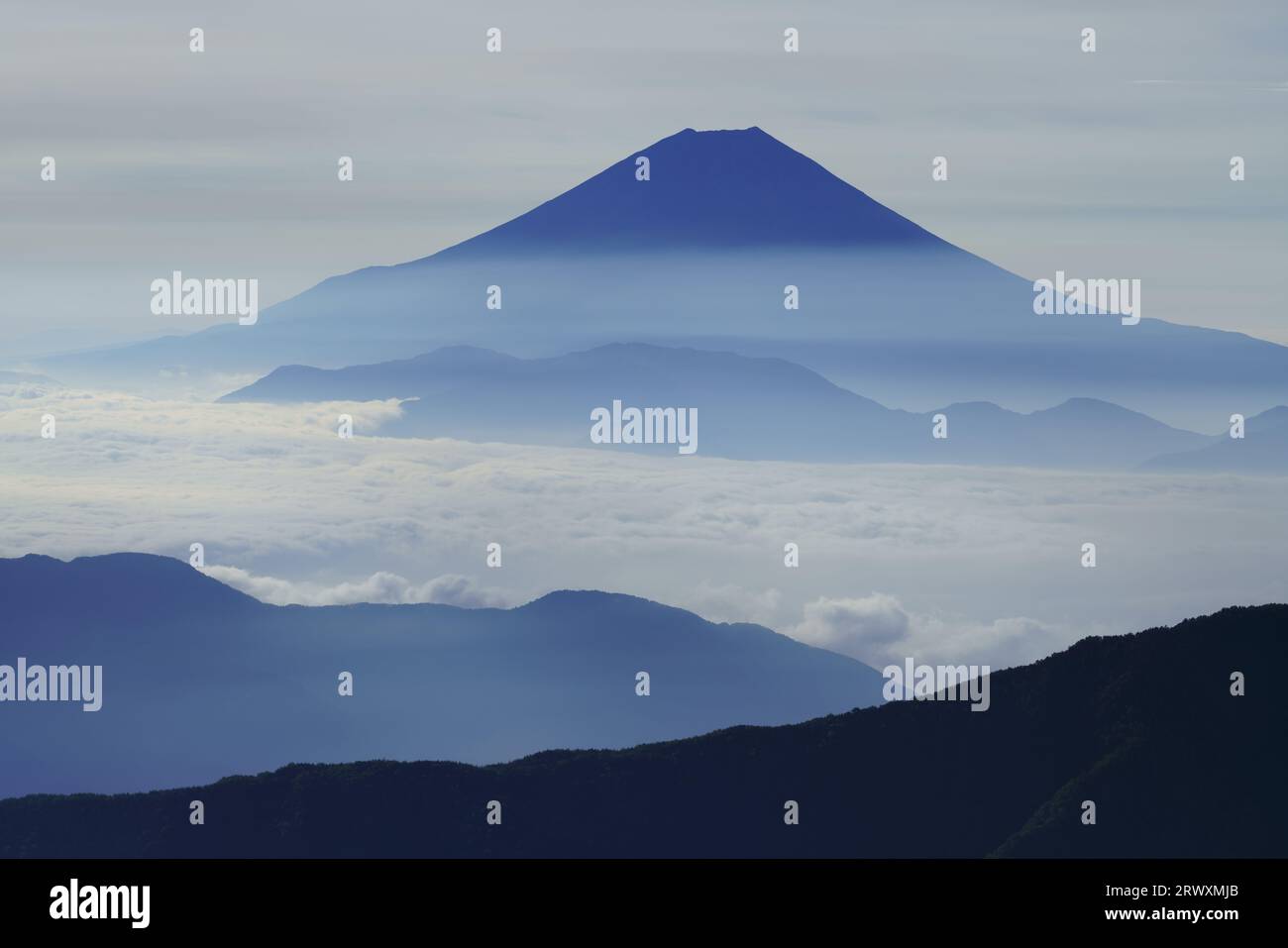 Fuji and Morning Mist Stock Photohttps://www.alamy.com/image-license-details/?v=1https://www.alamy.com/fuji-and-morning-mist-image566685123.html
Fuji and Morning Mist Stock Photohttps://www.alamy.com/image-license-details/?v=1https://www.alamy.com/fuji-and-morning-mist-image566685123.htmlRF2RWXMJB–Fuji and Morning Mist
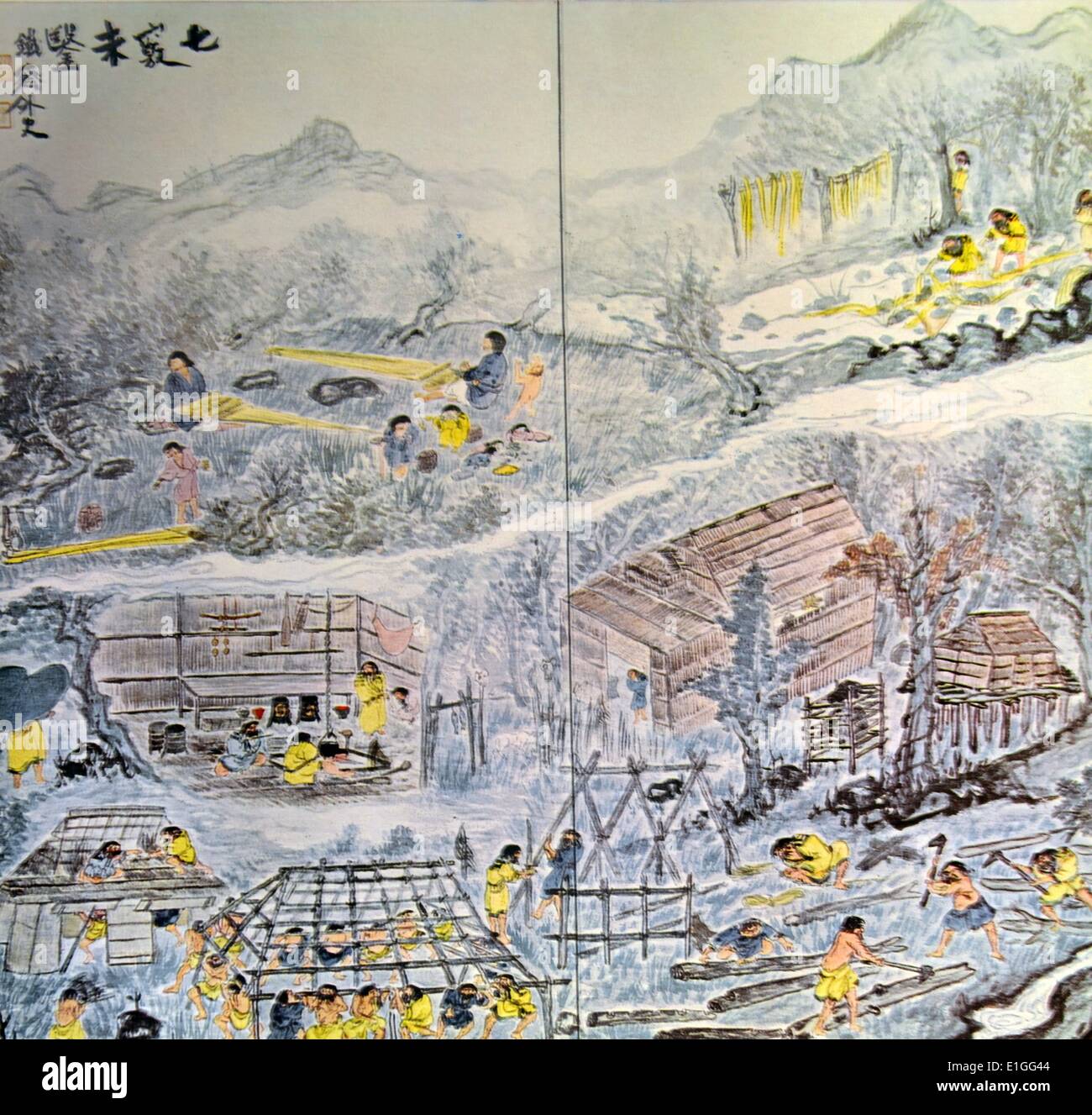 The large painting depicts different scenes of everyday life within an Ainu Village. By Tomioka Tessai (1837 - 1924) Japanese painter and Calligrapher in imperial Japan and one the first major artists of the Nihonga style. Dated 1870 Stock Photohttps://www.alamy.com/image-license-details/?v=1https://www.alamy.com/the-large-painting-depicts-different-scenes-of-everyday-life-within-image69820020.html
The large painting depicts different scenes of everyday life within an Ainu Village. By Tomioka Tessai (1837 - 1924) Japanese painter and Calligrapher in imperial Japan and one the first major artists of the Nihonga style. Dated 1870 Stock Photohttps://www.alamy.com/image-license-details/?v=1https://www.alamy.com/the-large-painting-depicts-different-scenes-of-everyday-life-within-image69820020.htmlRME1GG44–The large painting depicts different scenes of everyday life within an Ainu Village. By Tomioka Tessai (1837 - 1924) Japanese painter and Calligrapher in imperial Japan and one the first major artists of the Nihonga style. Dated 1870
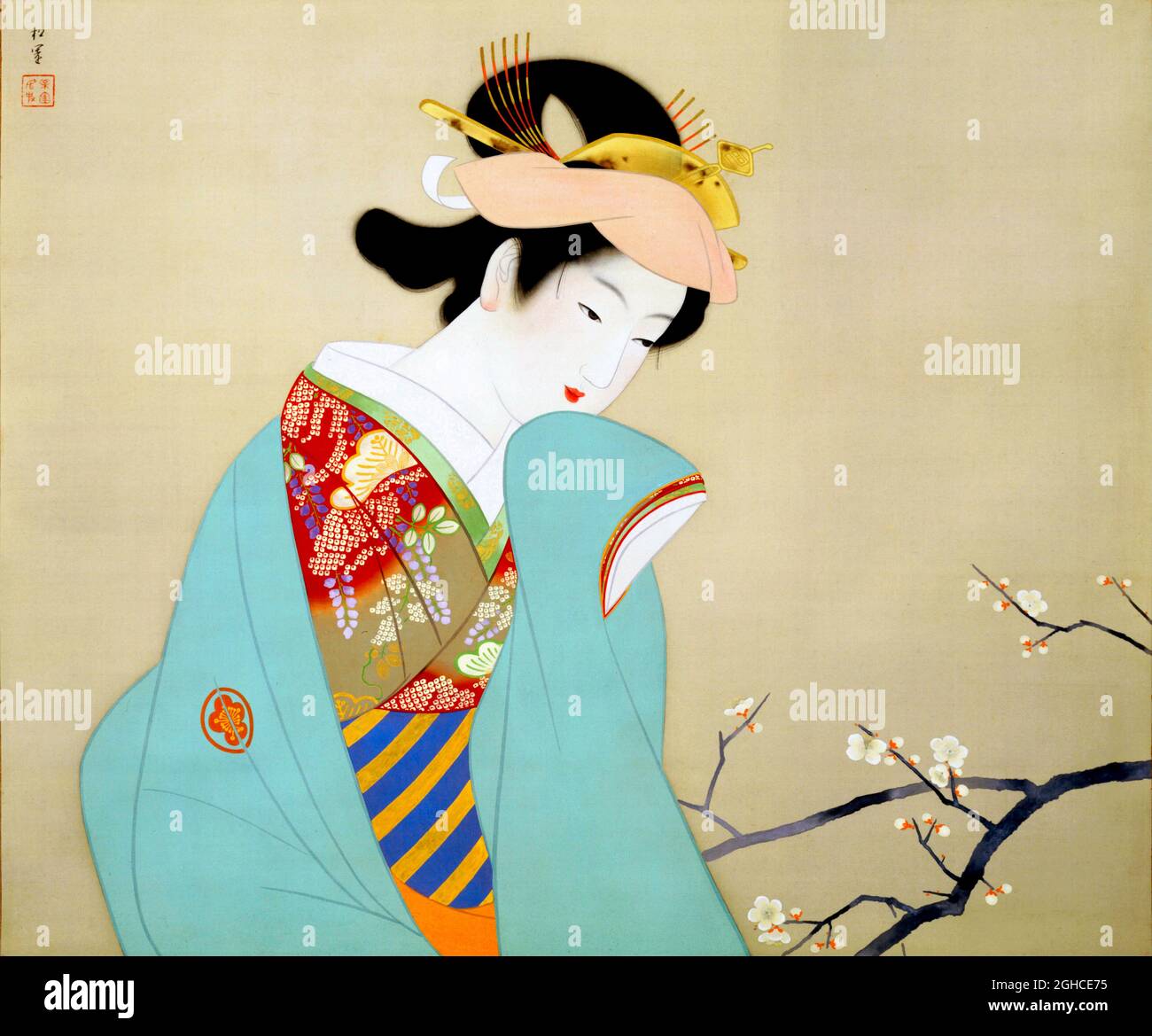 Fragrance of Spring by the Japanese artist, Uemura Shōen (1875-1949), colour on silk, 1940 Stock Photohttps://www.alamy.com/image-license-details/?v=1https://www.alamy.com/fragrance-of-spring-by-the-japanese-artist-uemura-shen-1875-1949-colour-on-silk-1940-image440982953.html
Fragrance of Spring by the Japanese artist, Uemura Shōen (1875-1949), colour on silk, 1940 Stock Photohttps://www.alamy.com/image-license-details/?v=1https://www.alamy.com/fragrance-of-spring-by-the-japanese-artist-uemura-shen-1875-1949-colour-on-silk-1940-image440982953.htmlRM2GHCE75–Fragrance of Spring by the Japanese artist, Uemura Shōen (1875-1949), colour on silk, 1940
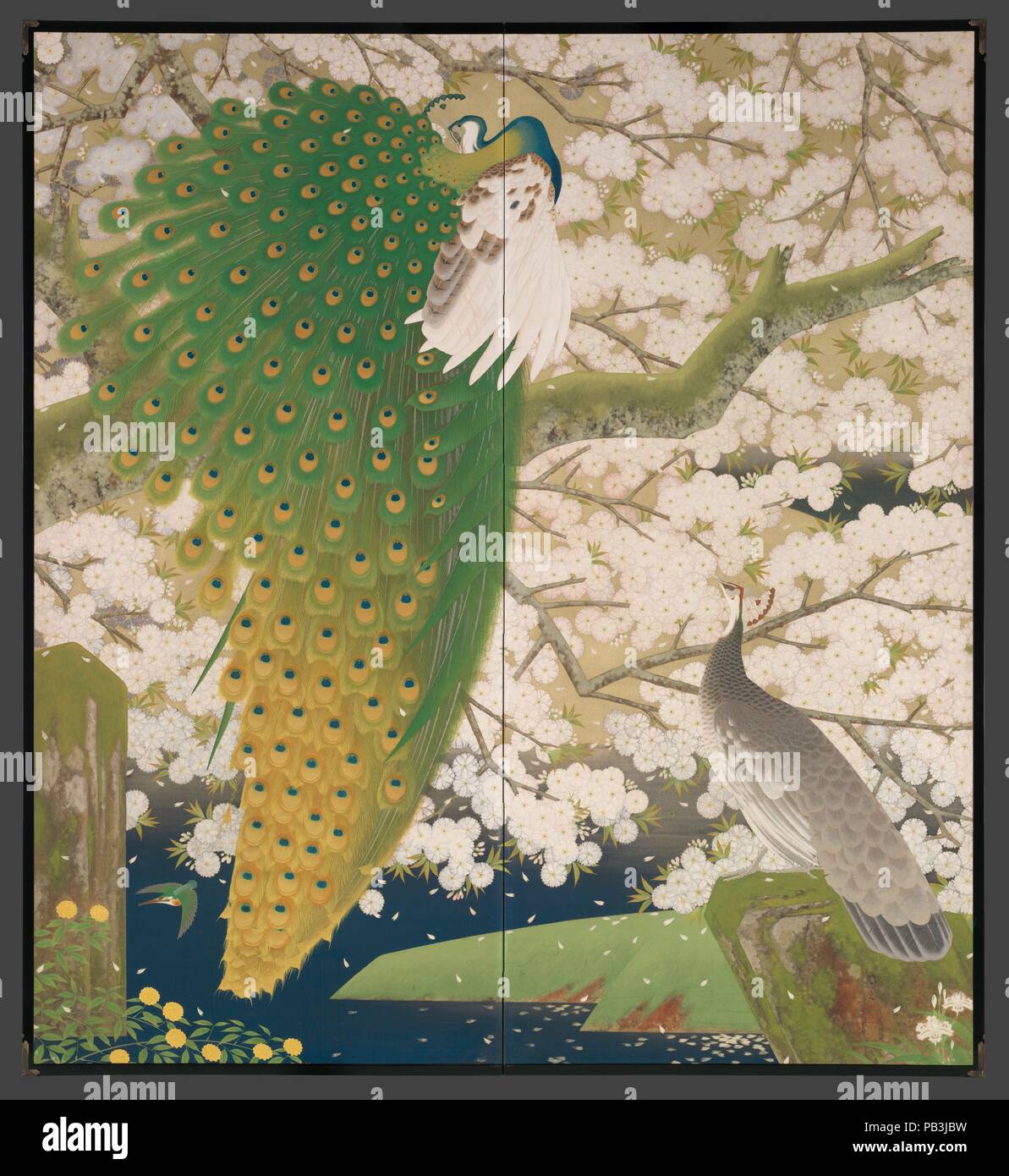 Peacocks and Cherry Tree. Artist: Imazu Tatsuyuki (Japanese, active early 20th century). Culture: Japan. Dimensions: Image: 80 1/8 × 72 13/16 in. (203.5 × 185 cm). Date: ca. 1925. Against the brilliantly rendered background of a cherry tree in full bloom, a peacock is perched upon a branch with its tail feathers gloriously arrayed while the peahen with subdued plumage looks upwards towards her flamboyant companion. The nearly pristine layers of thickly applied mineral pigments cover the entire surface of this tour-de-force of modern painting. Characteristic of nihonga (Japanese-style painting Stock Photohttps://www.alamy.com/image-license-details/?v=1https://www.alamy.com/peacocks-and-cherry-tree-artist-imazu-tatsuyuki-japanese-active-early-20th-century-culture-japan-dimensions-image-80-18-72-1316-in-2035-185-cm-date-ca-1925-against-the-brilliantly-rendered-background-of-a-cherry-tree-in-full-bloom-a-peacock-is-perched-upon-a-branch-with-its-tail-feathers-gloriously-arrayed-while-the-peahen-with-subdued-plumage-looks-upwards-towards-her-flamboyant-companion-the-nearly-pristine-layers-of-thickly-applied-mineral-pigments-cover-the-entire-surface-of-this-tour-de-force-of-modern-painting-characteristic-of-nihonga-japanese-style-painting-image213365933.html
Peacocks and Cherry Tree. Artist: Imazu Tatsuyuki (Japanese, active early 20th century). Culture: Japan. Dimensions: Image: 80 1/8 × 72 13/16 in. (203.5 × 185 cm). Date: ca. 1925. Against the brilliantly rendered background of a cherry tree in full bloom, a peacock is perched upon a branch with its tail feathers gloriously arrayed while the peahen with subdued plumage looks upwards towards her flamboyant companion. The nearly pristine layers of thickly applied mineral pigments cover the entire surface of this tour-de-force of modern painting. Characteristic of nihonga (Japanese-style painting Stock Photohttps://www.alamy.com/image-license-details/?v=1https://www.alamy.com/peacocks-and-cherry-tree-artist-imazu-tatsuyuki-japanese-active-early-20th-century-culture-japan-dimensions-image-80-18-72-1316-in-2035-185-cm-date-ca-1925-against-the-brilliantly-rendered-background-of-a-cherry-tree-in-full-bloom-a-peacock-is-perched-upon-a-branch-with-its-tail-feathers-gloriously-arrayed-while-the-peahen-with-subdued-plumage-looks-upwards-towards-her-flamboyant-companion-the-nearly-pristine-layers-of-thickly-applied-mineral-pigments-cover-the-entire-surface-of-this-tour-de-force-of-modern-painting-characteristic-of-nihonga-japanese-style-painting-image213365933.htmlRMPB3JBW–Peacocks and Cherry Tree. Artist: Imazu Tatsuyuki (Japanese, active early 20th century). Culture: Japan. Dimensions: Image: 80 1/8 × 72 13/16 in. (203.5 × 185 cm). Date: ca. 1925. Against the brilliantly rendered background of a cherry tree in full bloom, a peacock is perched upon a branch with its tail feathers gloriously arrayed while the peahen with subdued plumage looks upwards towards her flamboyant companion. The nearly pristine layers of thickly applied mineral pigments cover the entire surface of this tour-de-force of modern painting. Characteristic of nihonga (Japanese-style painting
 Dragon painting. Senso-ji temple, Asakusa Stock Photohttps://www.alamy.com/image-license-details/?v=1https://www.alamy.com/stock-photo-dragon-painting-senso-ji-temple-asakusa-59343712.html
Dragon painting. Senso-ji temple, Asakusa Stock Photohttps://www.alamy.com/image-license-details/?v=1https://www.alamy.com/stock-photo-dragon-painting-senso-ji-temple-asakusa-59343712.htmlRMDCF9E8–Dragon painting. Senso-ji temple, Asakusa
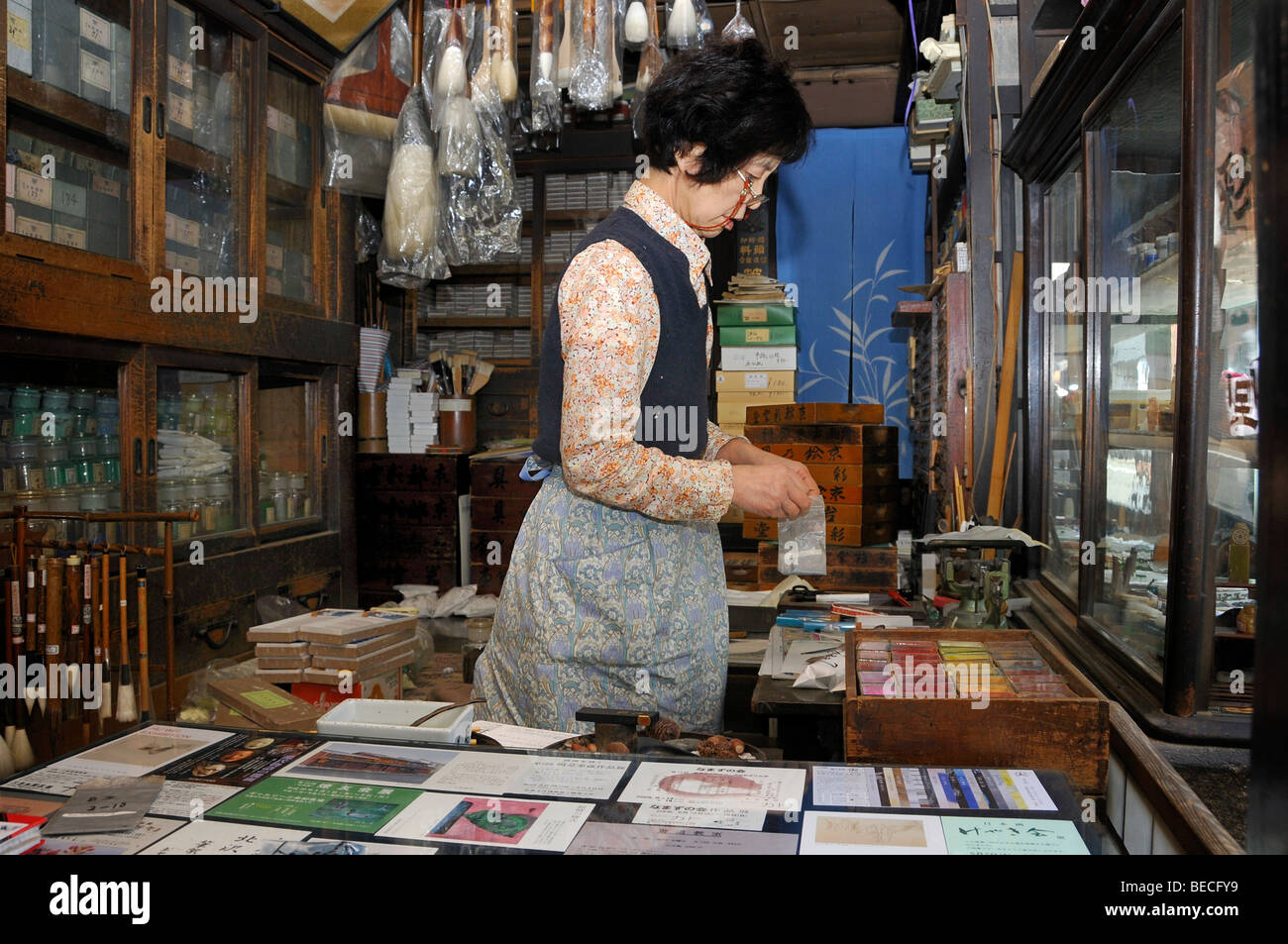 Sales clerk kneeling on a tatami mat and weighing mineral colours for Nihonga painting in a traditional shop for art supplies, Stock Photohttps://www.alamy.com/image-license-details/?v=1https://www.alamy.com/stock-photo-sales-clerk-kneeling-on-a-tatami-mat-and-weighing-mineral-colours-26091501.html
Sales clerk kneeling on a tatami mat and weighing mineral colours for Nihonga painting in a traditional shop for art supplies, Stock Photohttps://www.alamy.com/image-license-details/?v=1https://www.alamy.com/stock-photo-sales-clerk-kneeling-on-a-tatami-mat-and-weighing-mineral-colours-26091501.htmlRMBECFY9–Sales clerk kneeling on a tatami mat and weighing mineral colours for Nihonga painting in a traditional shop for art supplies,
 Six-fold screen depicting creatures and flowers of the twelve months, 1900. Dimensions: 60 cm (height) ; 174 cm (width). Stock Photohttps://www.alamy.com/image-license-details/?v=1https://www.alamy.com/six-fold-screen-depicting-creatures-and-flowers-of-the-twelve-months-1900-dimensions-60-cm-height-174-cm-width-image462501334.html
Six-fold screen depicting creatures and flowers of the twelve months, 1900. Dimensions: 60 cm (height) ; 174 cm (width). Stock Photohttps://www.alamy.com/image-license-details/?v=1https://www.alamy.com/six-fold-screen-depicting-creatures-and-flowers-of-the-twelve-months-1900-dimensions-60-cm-height-174-cm-width-image462501334.htmlRM2HTCN4P–Six-fold screen depicting creatures and flowers of the twelve months, 1900. Dimensions: 60 cm (height) ; 174 cm (width).
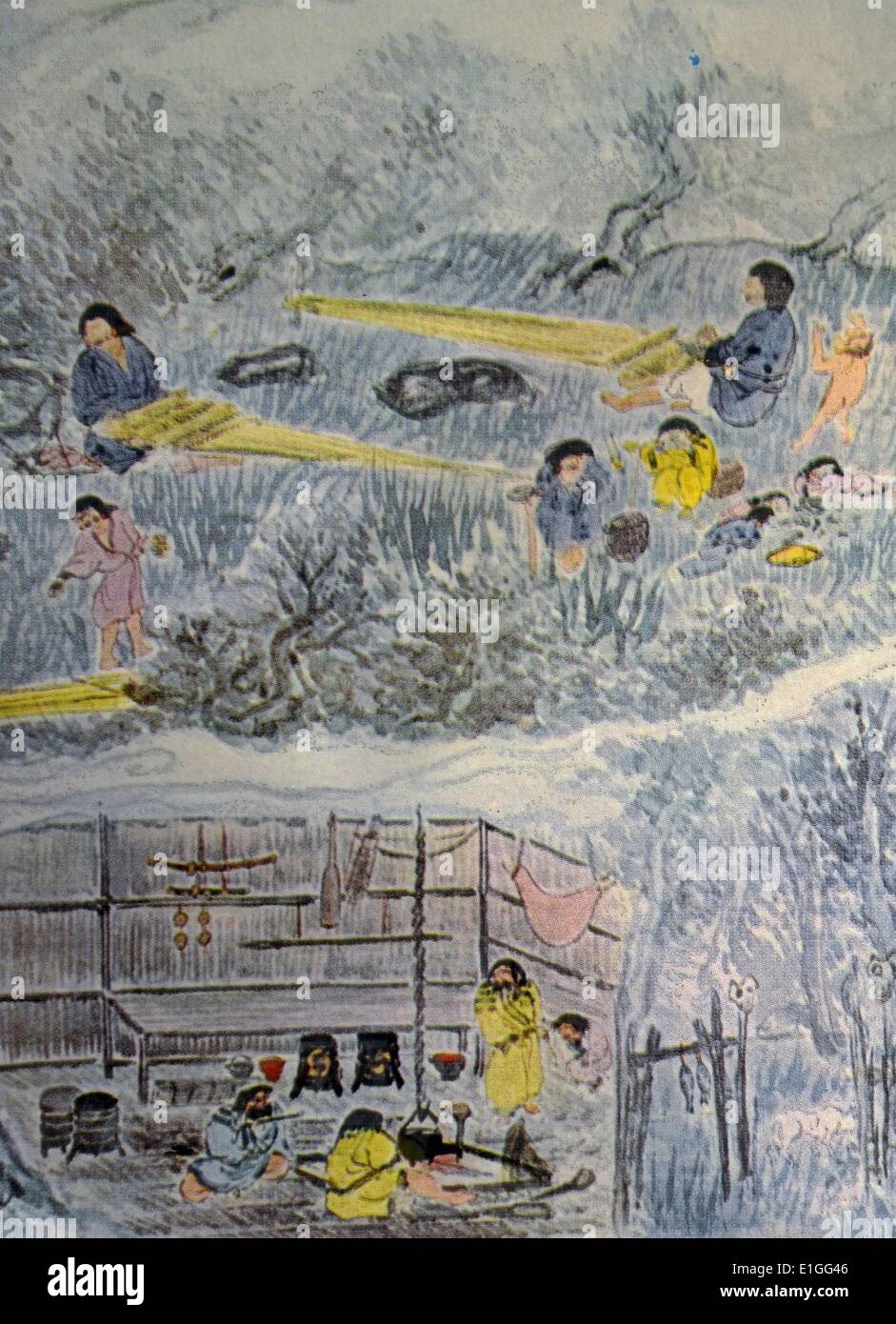 The large painting depicts different scenes of everyday life within an Ainu Village. By Tomioka Tessai (1837 - 1924) Japanese painter and Calligrapher in imperial Japan and one the first major artists of the Nihonga style. Dated 1870 Stock Photohttps://www.alamy.com/image-license-details/?v=1https://www.alamy.com/the-large-painting-depicts-different-scenes-of-everyday-life-within-image69820022.html
The large painting depicts different scenes of everyday life within an Ainu Village. By Tomioka Tessai (1837 - 1924) Japanese painter and Calligrapher in imperial Japan and one the first major artists of the Nihonga style. Dated 1870 Stock Photohttps://www.alamy.com/image-license-details/?v=1https://www.alamy.com/the-large-painting-depicts-different-scenes-of-everyday-life-within-image69820022.htmlRME1GG46–The large painting depicts different scenes of everyday life within an Ainu Village. By Tomioka Tessai (1837 - 1924) Japanese painter and Calligrapher in imperial Japan and one the first major artists of the Nihonga style. Dated 1870
 Parting Spring. Museum: National Museum of Modern Art, Tokyo. Author: KAWAI GYOKUDO. Stock Photohttps://www.alamy.com/image-license-details/?v=1https://www.alamy.com/parting-spring-museum-national-museum-of-modern-art-tokyo-author-kawai-gyokudo-image612034071.html
Parting Spring. Museum: National Museum of Modern Art, Tokyo. Author: KAWAI GYOKUDO. Stock Photohttps://www.alamy.com/image-license-details/?v=1https://www.alamy.com/parting-spring-museum-national-museum-of-modern-art-tokyo-author-kawai-gyokudo-image612034071.htmlRM2XFMFKK–Parting Spring. Museum: National Museum of Modern Art, Tokyo. Author: KAWAI GYOKUDO.
 Sales clerk kneeling on a tatami mat and showing different mineral colours for Nihonga painting in a traditional shop for art s Stock Photohttps://www.alamy.com/image-license-details/?v=1https://www.alamy.com/stock-photo-sales-clerk-kneeling-on-a-tatami-mat-and-showing-different-mineral-26089968.html
Sales clerk kneeling on a tatami mat and showing different mineral colours for Nihonga painting in a traditional shop for art s Stock Photohttps://www.alamy.com/image-license-details/?v=1https://www.alamy.com/stock-photo-sales-clerk-kneeling-on-a-tatami-mat-and-showing-different-mineral-26089968.htmlRMBECE0G–Sales clerk kneeling on a tatami mat and showing different mineral colours for Nihonga painting in a traditional shop for art s
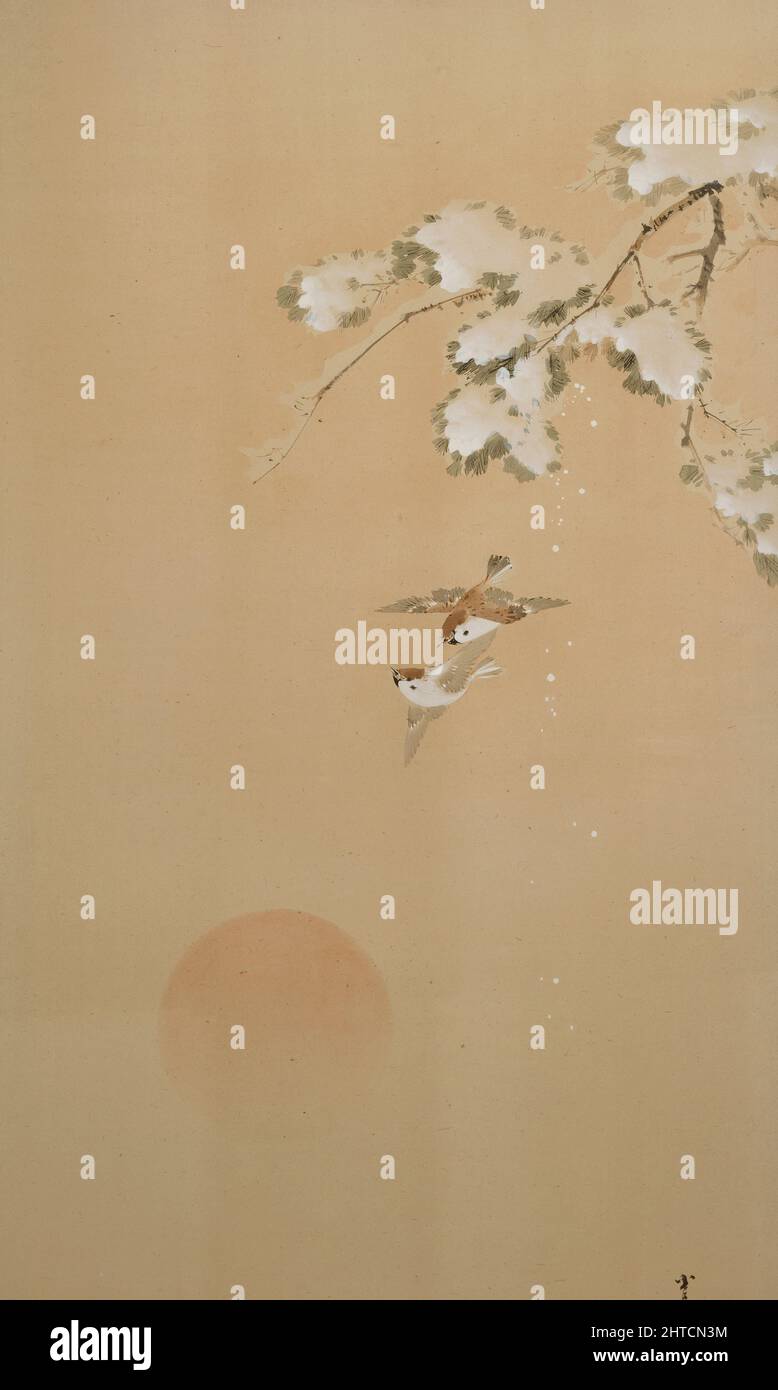 Six-fold screen depicting creatures and flowers of the twelve months, 1900. Dimensions: 60 cm (height) ; 174 cm (width). Stock Photohttps://www.alamy.com/image-license-details/?v=1https://www.alamy.com/six-fold-screen-depicting-creatures-and-flowers-of-the-twelve-months-1900-dimensions-60-cm-height-174-cm-width-image462501304.html
Six-fold screen depicting creatures and flowers of the twelve months, 1900. Dimensions: 60 cm (height) ; 174 cm (width). Stock Photohttps://www.alamy.com/image-license-details/?v=1https://www.alamy.com/six-fold-screen-depicting-creatures-and-flowers-of-the-twelve-months-1900-dimensions-60-cm-height-174-cm-width-image462501304.htmlRM2HTCN3M–Six-fold screen depicting creatures and flowers of the twelve months, 1900. Dimensions: 60 cm (height) ; 174 cm (width).
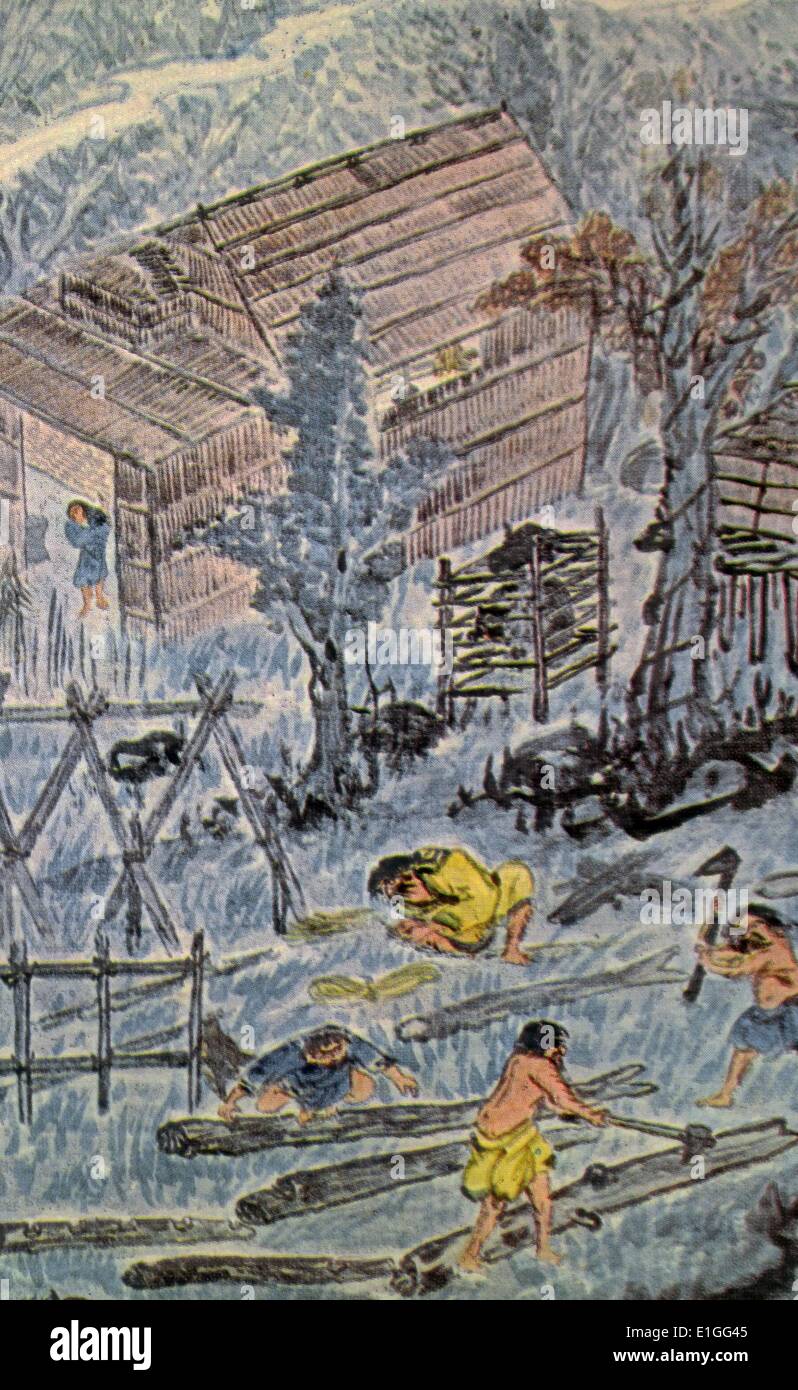 The large painting depicts different scenes of everyday life within an Ainu Village. By Tomioka Tessai (1837 - 1924) Japanese painter and Calligrapher in imperial Japan and one the first major artists of the Nihonga style. Dated 1870 Stock Photohttps://www.alamy.com/image-license-details/?v=1https://www.alamy.com/the-large-painting-depicts-different-scenes-of-everyday-life-within-image69820021.html
The large painting depicts different scenes of everyday life within an Ainu Village. By Tomioka Tessai (1837 - 1924) Japanese painter and Calligrapher in imperial Japan and one the first major artists of the Nihonga style. Dated 1870 Stock Photohttps://www.alamy.com/image-license-details/?v=1https://www.alamy.com/the-large-painting-depicts-different-scenes-of-everyday-life-within-image69820021.htmlRME1GG45–The large painting depicts different scenes of everyday life within an Ainu Village. By Tomioka Tessai (1837 - 1924) Japanese painter and Calligrapher in imperial Japan and one the first major artists of the Nihonga style. Dated 1870
 Ryukozu (Dragon and tiger). Museum: Seikado Bunko Art Museum. Author: Hashimoto Gaho. Stock Photohttps://www.alamy.com/image-license-details/?v=1https://www.alamy.com/ryukozu-dragon-and-tiger-museum-seikado-bunko-art-museum-author-hashimoto-gaho-image612035208.html
Ryukozu (Dragon and tiger). Museum: Seikado Bunko Art Museum. Author: Hashimoto Gaho. Stock Photohttps://www.alamy.com/image-license-details/?v=1https://www.alamy.com/ryukozu-dragon-and-tiger-museum-seikado-bunko-art-museum-author-hashimoto-gaho-image612035208.htmlRM2XFMH48–Ryukozu (Dragon and tiger). Museum: Seikado Bunko Art Museum. Author: Hashimoto Gaho.
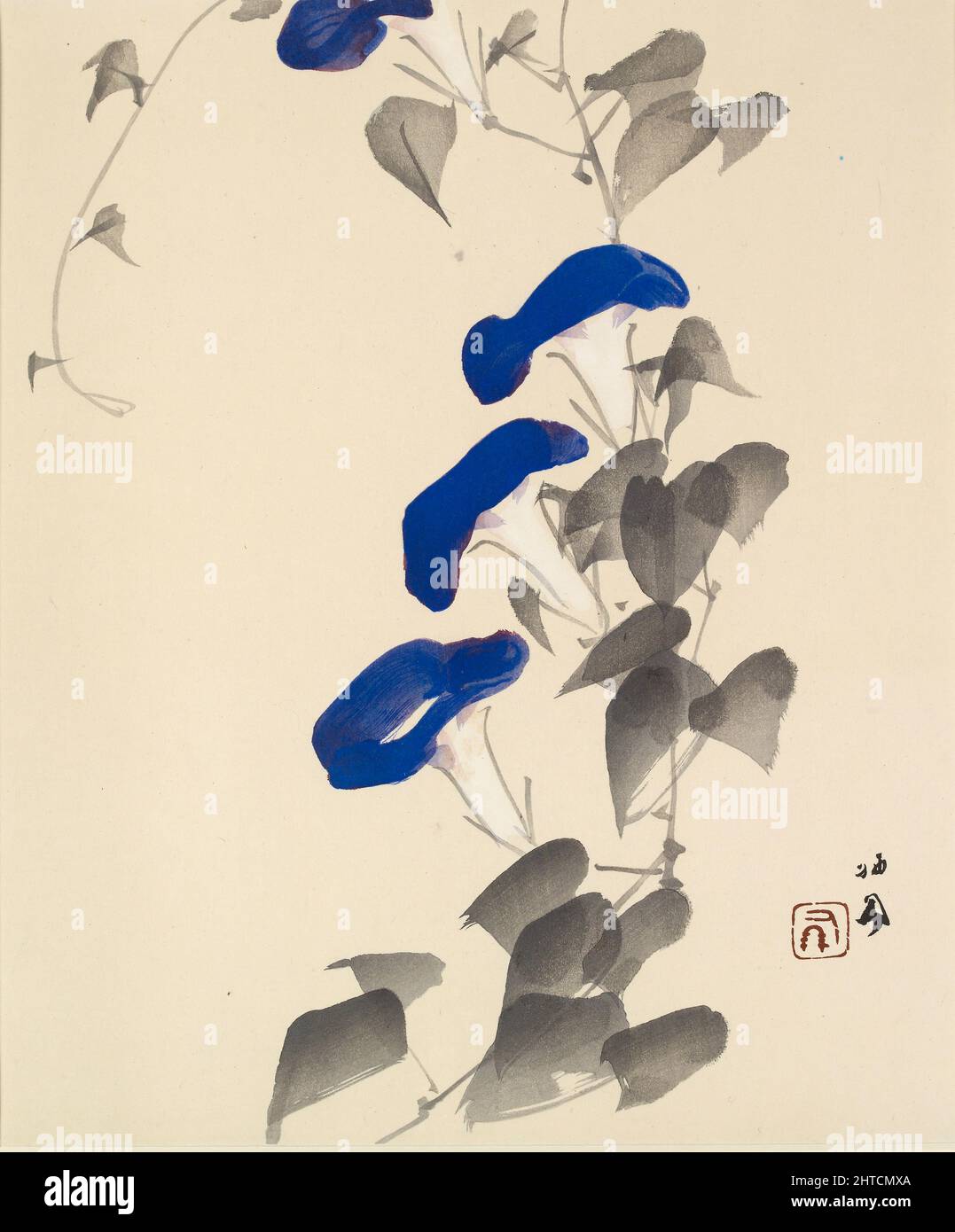 Morning glory, 1901 - 1942. Dimensions: sheet 40.4 x 33.7 cm sight size (height x width). Stock Photohttps://www.alamy.com/image-license-details/?v=1https://www.alamy.com/morning-glory-1901-1942-dimensions-sheet-404-x-337-cm-sight-size-height-x-width-image462501154.html
Morning glory, 1901 - 1942. Dimensions: sheet 40.4 x 33.7 cm sight size (height x width). Stock Photohttps://www.alamy.com/image-license-details/?v=1https://www.alamy.com/morning-glory-1901-1942-dimensions-sheet-404-x-337-cm-sight-size-height-x-width-image462501154.htmlRM2HTCMXA–Morning glory, 1901 - 1942. Dimensions: sheet 40.4 x 33.7 cm sight size (height x width).
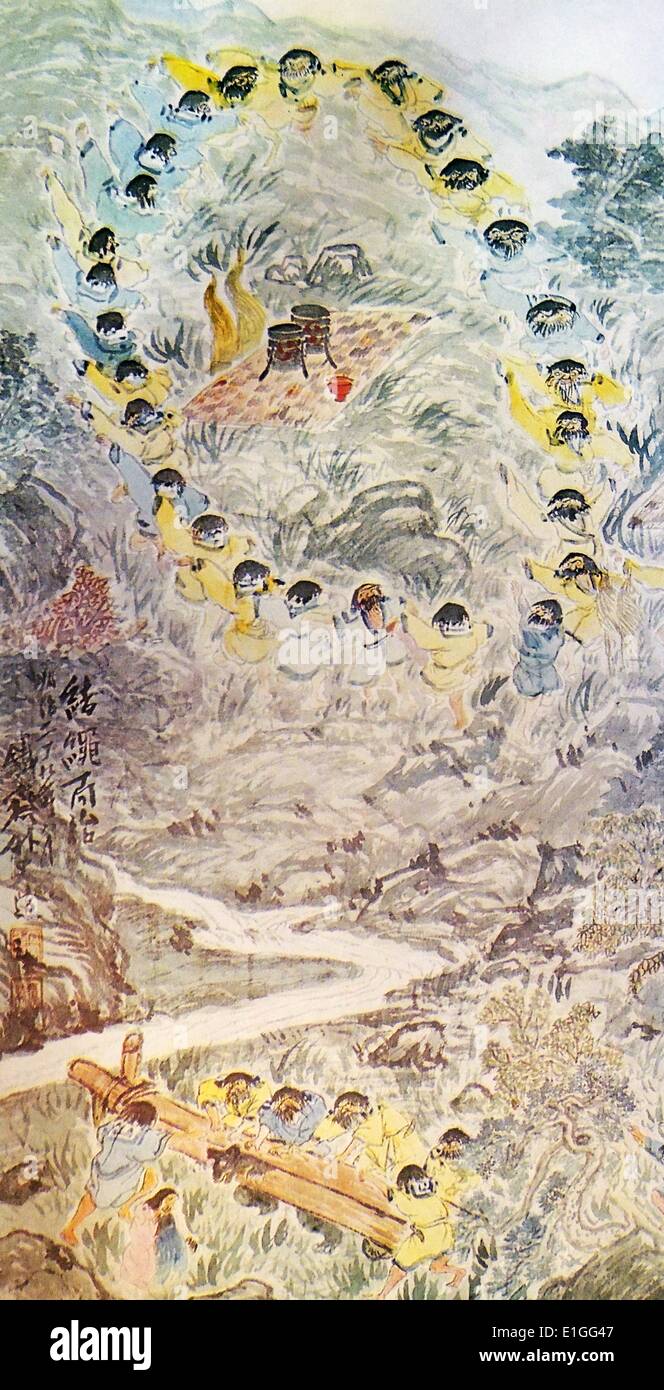 The large painting depicts different scenes of everyday life within an Ainu Village. By Tomioka Tessai (1837 - 1924) Japanese painter and Calligrapher in imperial Japan and one the first major artists of the Nihonga style. Dated 1870 Stock Photohttps://www.alamy.com/image-license-details/?v=1https://www.alamy.com/the-large-painting-depicts-different-scenes-of-everyday-life-within-image69820023.html
The large painting depicts different scenes of everyday life within an Ainu Village. By Tomioka Tessai (1837 - 1924) Japanese painter and Calligrapher in imperial Japan and one the first major artists of the Nihonga style. Dated 1870 Stock Photohttps://www.alamy.com/image-license-details/?v=1https://www.alamy.com/the-large-painting-depicts-different-scenes-of-everyday-life-within-image69820023.htmlRME1GG47–The large painting depicts different scenes of everyday life within an Ainu Village. By Tomioka Tessai (1837 - 1924) Japanese painter and Calligrapher in imperial Japan and one the first major artists of the Nihonga style. Dated 1870
 Yoroboshi (Scene from Noh play). Museum: Tokyo National Museum. Author: Shimomura Kanzan. Stock Photohttps://www.alamy.com/image-license-details/?v=1https://www.alamy.com/yoroboshi-scene-from-noh-play-museum-tokyo-national-museum-author-shimomura-kanzan-image612033428.html
Yoroboshi (Scene from Noh play). Museum: Tokyo National Museum. Author: Shimomura Kanzan. Stock Photohttps://www.alamy.com/image-license-details/?v=1https://www.alamy.com/yoroboshi-scene-from-noh-play-museum-tokyo-national-museum-author-shimomura-kanzan-image612033428.htmlRM2XFMETM–Yoroboshi (Scene from Noh play). Museum: Tokyo National Museum. Author: Shimomura Kanzan.
 Ryukozu (Dragon and tiger), 1895. Found in the Collection of the Seikado Bunko Art Museum. Stock Photohttps://www.alamy.com/image-license-details/?v=1https://www.alamy.com/ryukozu-dragon-and-tiger-1895-found-in-the-collection-of-the-seikado-bunko-art-museum-image617197077.html
Ryukozu (Dragon and tiger), 1895. Found in the Collection of the Seikado Bunko Art Museum. Stock Photohttps://www.alamy.com/image-license-details/?v=1https://www.alamy.com/ryukozu-dragon-and-tiger-1895-found-in-the-collection-of-the-seikado-bunko-art-museum-image617197077.htmlRM2XT3N4N–Ryukozu (Dragon and tiger), 1895. Found in the Collection of the Seikado Bunko Art Museum.
 Yoroboshi (Scene from Noh play), 1915. Found in the Collection of the Tokyo National Museum. Stock Photohttps://www.alamy.com/image-license-details/?v=1https://www.alamy.com/yoroboshi-scene-from-noh-play-1915-found-in-the-collection-of-the-tokyo-national-museum-image617197083.html
Yoroboshi (Scene from Noh play), 1915. Found in the Collection of the Tokyo National Museum. Stock Photohttps://www.alamy.com/image-license-details/?v=1https://www.alamy.com/yoroboshi-scene-from-noh-play-1915-found-in-the-collection-of-the-tokyo-national-museum-image617197083.htmlRM2XT3N4Y–Yoroboshi (Scene from Noh play), 1915. Found in the Collection of the Tokyo National Museum.
 The Twelve Months, between 1900 and 1918. Stock Photohttps://www.alamy.com/image-license-details/?v=1https://www.alamy.com/the-twelve-months-between-1900-and-1918-image485261301.html
The Twelve Months, between 1900 and 1918. Stock Photohttps://www.alamy.com/image-license-details/?v=1https://www.alamy.com/the-twelve-months-between-1900-and-1918-image485261301.htmlRM2K5DFMN–The Twelve Months, between 1900 and 1918.
 The Twelve Months, between 1900 and 1918. Stock Photohttps://www.alamy.com/image-license-details/?v=1https://www.alamy.com/the-twelve-months-between-1900-and-1918-image485261165.html
The Twelve Months, between 1900 and 1918. Stock Photohttps://www.alamy.com/image-license-details/?v=1https://www.alamy.com/the-twelve-months-between-1900-and-1918-image485261165.htmlRM2K5DFFW–The Twelve Months, between 1900 and 1918.
 The Twelve Months: Tenth Month, between 1900 and 1918. Stock Photohttps://www.alamy.com/image-license-details/?v=1https://www.alamy.com/the-twelve-months-tenth-month-between-1900-and-1918-image485261056.html
The Twelve Months: Tenth Month, between 1900 and 1918. Stock Photohttps://www.alamy.com/image-license-details/?v=1https://www.alamy.com/the-twelve-months-tenth-month-between-1900-and-1918-image485261056.htmlRM2K5DFC0–The Twelve Months: Tenth Month, between 1900 and 1918.
 The Twelve Months, between 1900 and 1918. Stock Photohttps://www.alamy.com/image-license-details/?v=1https://www.alamy.com/the-twelve-months-between-1900-and-1918-image485261299.html
The Twelve Months, between 1900 and 1918. Stock Photohttps://www.alamy.com/image-license-details/?v=1https://www.alamy.com/the-twelve-months-between-1900-and-1918-image485261299.htmlRM2K5DFMK–The Twelve Months, between 1900 and 1918.
 The Twelve Months: Fourth Month, between 1900 and 1918. Stock Photohttps://www.alamy.com/image-license-details/?v=1https://www.alamy.com/the-twelve-months-fourth-month-between-1900-and-1918-image485260811.html
The Twelve Months: Fourth Month, between 1900 and 1918. Stock Photohttps://www.alamy.com/image-license-details/?v=1https://www.alamy.com/the-twelve-months-fourth-month-between-1900-and-1918-image485260811.htmlRM2K5DF37–The Twelve Months: Fourth Month, between 1900 and 1918.
 The Twelve Months: Twelfth Month, between 1900 and 1918. Stock Photohttps://www.alamy.com/image-license-details/?v=1https://www.alamy.com/the-twelve-months-twelfth-month-between-1900-and-1918-image485261135.html
The Twelve Months: Twelfth Month, between 1900 and 1918. Stock Photohttps://www.alamy.com/image-license-details/?v=1https://www.alamy.com/the-twelve-months-twelfth-month-between-1900-and-1918-image485261135.htmlRM2K5DFER–The Twelve Months: Twelfth Month, between 1900 and 1918.
 The Twelve Months: Twelfth Month, between 1900 and 1918. Stock Photohttps://www.alamy.com/image-license-details/?v=1https://www.alamy.com/the-twelve-months-twelfth-month-between-1900-and-1918-image485261142.html
The Twelve Months: Twelfth Month, between 1900 and 1918. Stock Photohttps://www.alamy.com/image-license-details/?v=1https://www.alamy.com/the-twelve-months-twelfth-month-between-1900-and-1918-image485261142.htmlRM2K5DFF2–The Twelve Months: Twelfth Month, between 1900 and 1918.
 The Twelve Months: Second Month, between 1900 and 1918. Stock Photohttps://www.alamy.com/image-license-details/?v=1https://www.alamy.com/the-twelve-months-second-month-between-1900-and-1918-image485260745.html
The Twelve Months: Second Month, between 1900 and 1918. Stock Photohttps://www.alamy.com/image-license-details/?v=1https://www.alamy.com/the-twelve-months-second-month-between-1900-and-1918-image485260745.htmlRM2K5DF0W–The Twelve Months: Second Month, between 1900 and 1918.
 The Twelve Months, between 1900 and 1918. Stock Photohttps://www.alamy.com/image-license-details/?v=1https://www.alamy.com/the-twelve-months-between-1900-and-1918-image485261162.html
The Twelve Months, between 1900 and 1918. Stock Photohttps://www.alamy.com/image-license-details/?v=1https://www.alamy.com/the-twelve-months-between-1900-and-1918-image485261162.htmlRM2K5DFFP–The Twelve Months, between 1900 and 1918.
 The Twelve Months: Eleventh Month, between 1900 and 1918. Stock Photohttps://www.alamy.com/image-license-details/?v=1https://www.alamy.com/the-twelve-months-eleventh-month-between-1900-and-1918-image485261048.html
The Twelve Months: Eleventh Month, between 1900 and 1918. Stock Photohttps://www.alamy.com/image-license-details/?v=1https://www.alamy.com/the-twelve-months-eleventh-month-between-1900-and-1918-image485261048.htmlRM2K5DFBM–The Twelve Months: Eleventh Month, between 1900 and 1918.
 The Twelve Months: Sixth Month, between 1900 and 1918. Stock Photohttps://www.alamy.com/image-license-details/?v=1https://www.alamy.com/the-twelve-months-sixth-month-between-1900-and-1918-image485260892.html
The Twelve Months: Sixth Month, between 1900 and 1918. Stock Photohttps://www.alamy.com/image-license-details/?v=1https://www.alamy.com/the-twelve-months-sixth-month-between-1900-and-1918-image485260892.htmlRM2K5DF64–The Twelve Months: Sixth Month, between 1900 and 1918.
 The Twelve Months, between 1900 and 1918. Stock Photohttps://www.alamy.com/image-license-details/?v=1https://www.alamy.com/the-twelve-months-between-1900-and-1918-image485261202.html
The Twelve Months, between 1900 and 1918. Stock Photohttps://www.alamy.com/image-license-details/?v=1https://www.alamy.com/the-twelve-months-between-1900-and-1918-image485261202.htmlRM2K5DFH6–The Twelve Months, between 1900 and 1918.
 The Twelve Months: Eleventh Month, between 1900 and 1918. Stock Photohttps://www.alamy.com/image-license-details/?v=1https://www.alamy.com/the-twelve-months-eleventh-month-between-1900-and-1918-image485261131.html
The Twelve Months: Eleventh Month, between 1900 and 1918. Stock Photohttps://www.alamy.com/image-license-details/?v=1https://www.alamy.com/the-twelve-months-eleventh-month-between-1900-and-1918-image485261131.htmlRM2K5DFEK–The Twelve Months: Eleventh Month, between 1900 and 1918.
 The Twelve Months, between 1900 and 1918. Stock Photohttps://www.alamy.com/image-license-details/?v=1https://www.alamy.com/the-twelve-months-between-1900-and-1918-image485261190.html
The Twelve Months, between 1900 and 1918. Stock Photohttps://www.alamy.com/image-license-details/?v=1https://www.alamy.com/the-twelve-months-between-1900-and-1918-image485261190.htmlRM2K5DFGP–The Twelve Months, between 1900 and 1918.
 The Twelve Months, between 1900 and 1918. Stock Photohttps://www.alamy.com/image-license-details/?v=1https://www.alamy.com/the-twelve-months-between-1900-and-1918-image485261281.html
The Twelve Months, between 1900 and 1918. Stock Photohttps://www.alamy.com/image-license-details/?v=1https://www.alamy.com/the-twelve-months-between-1900-and-1918-image485261281.htmlRM2K5DFM1–The Twelve Months, between 1900 and 1918.
 The Twelve Months: Sixth Month, between 1900 and 1918. Stock Photohttps://www.alamy.com/image-license-details/?v=1https://www.alamy.com/the-twelve-months-sixth-month-between-1900-and-1918-image485260820.html
The Twelve Months: Sixth Month, between 1900 and 1918. Stock Photohttps://www.alamy.com/image-license-details/?v=1https://www.alamy.com/the-twelve-months-sixth-month-between-1900-and-1918-image485260820.htmlRM2K5DF3G–The Twelve Months: Sixth Month, between 1900 and 1918.
 The Twelve Months: Sixth Month, between 1900 and 1918. Stock Photohttps://www.alamy.com/image-license-details/?v=1https://www.alamy.com/the-twelve-months-sixth-month-between-1900-and-1918-image485260908.html
The Twelve Months: Sixth Month, between 1900 and 1918. Stock Photohttps://www.alamy.com/image-license-details/?v=1https://www.alamy.com/the-twelve-months-sixth-month-between-1900-and-1918-image485260908.htmlRM2K5DF6M–The Twelve Months: Sixth Month, between 1900 and 1918.
 The Twelve Months: Tenth Month, between 1900 and 1918. Stock Photohttps://www.alamy.com/image-license-details/?v=1https://www.alamy.com/the-twelve-months-tenth-month-between-1900-and-1918-image485261058.html
The Twelve Months: Tenth Month, between 1900 and 1918. Stock Photohttps://www.alamy.com/image-license-details/?v=1https://www.alamy.com/the-twelve-months-tenth-month-between-1900-and-1918-image485261058.htmlRM2K5DFC2–The Twelve Months: Tenth Month, between 1900 and 1918.
 The Twelve Months: Tenth Month, between 1900 and 1918. Stock Photohttps://www.alamy.com/image-license-details/?v=1https://www.alamy.com/the-twelve-months-tenth-month-between-1900-and-1918-image485261037.html
The Twelve Months: Tenth Month, between 1900 and 1918. Stock Photohttps://www.alamy.com/image-license-details/?v=1https://www.alamy.com/the-twelve-months-tenth-month-between-1900-and-1918-image485261037.htmlRM2K5DFB9–The Twelve Months: Tenth Month, between 1900 and 1918.
 The Twelve Months, between 1900 and 1918. Stock Photohttps://www.alamy.com/image-license-details/?v=1https://www.alamy.com/the-twelve-months-between-1900-and-1918-image485261291.html
The Twelve Months, between 1900 and 1918. Stock Photohttps://www.alamy.com/image-license-details/?v=1https://www.alamy.com/the-twelve-months-between-1900-and-1918-image485261291.htmlRM2K5DFMB–The Twelve Months, between 1900 and 1918.
 The Twelve Months: First Month, between 1900 and 1918. Stock Photohttps://www.alamy.com/image-license-details/?v=1https://www.alamy.com/the-twelve-months-first-month-between-1900-and-1918-image485260618.html
The Twelve Months: First Month, between 1900 and 1918. Stock Photohttps://www.alamy.com/image-license-details/?v=1https://www.alamy.com/the-twelve-months-first-month-between-1900-and-1918-image485260618.htmlRM2K5DETA–The Twelve Months: First Month, between 1900 and 1918.
 The Twelve Months: Ninth Month, between 1900 and 1918. Stock Photohttps://www.alamy.com/image-license-details/?v=1https://www.alamy.com/the-twelve-months-ninth-month-between-1900-and-1918-image485260958.html
The Twelve Months: Ninth Month, between 1900 and 1918. Stock Photohttps://www.alamy.com/image-license-details/?v=1https://www.alamy.com/the-twelve-months-ninth-month-between-1900-and-1918-image485260958.htmlRM2K5DF8E–The Twelve Months: Ninth Month, between 1900 and 1918.
 The Twelve Months: Ninth Month, between 1900 and 1918. Stock Photohttps://www.alamy.com/image-license-details/?v=1https://www.alamy.com/the-twelve-months-ninth-month-between-1900-and-1918-image485260977.html
The Twelve Months: Ninth Month, between 1900 and 1918. Stock Photohttps://www.alamy.com/image-license-details/?v=1https://www.alamy.com/the-twelve-months-ninth-month-between-1900-and-1918-image485260977.htmlRM2K5DF95–The Twelve Months: Ninth Month, between 1900 and 1918.
 The Twelve Months, between 1900 and 1918. Stock Photohttps://www.alamy.com/image-license-details/?v=1https://www.alamy.com/the-twelve-months-between-1900-and-1918-image485261258.html
The Twelve Months, between 1900 and 1918. Stock Photohttps://www.alamy.com/image-license-details/?v=1https://www.alamy.com/the-twelve-months-between-1900-and-1918-image485261258.htmlRM2K5DFK6–The Twelve Months, between 1900 and 1918.
 The Twelve Months: Eighth Month, between 1900 and 1918. Stock Photohttps://www.alamy.com/image-license-details/?v=1https://www.alamy.com/the-twelve-months-eighth-month-between-1900-and-1918-image485260914.html
The Twelve Months: Eighth Month, between 1900 and 1918. Stock Photohttps://www.alamy.com/image-license-details/?v=1https://www.alamy.com/the-twelve-months-eighth-month-between-1900-and-1918-image485260914.htmlRM2K5DF6X–The Twelve Months: Eighth Month, between 1900 and 1918.
 The Twelve Months: Seventh Month, between 1900 and 1918. Stock Photohttps://www.alamy.com/image-license-details/?v=1https://www.alamy.com/the-twelve-months-seventh-month-between-1900-and-1918-image485260894.html
The Twelve Months: Seventh Month, between 1900 and 1918. Stock Photohttps://www.alamy.com/image-license-details/?v=1https://www.alamy.com/the-twelve-months-seventh-month-between-1900-and-1918-image485260894.htmlRM2K5DF66–The Twelve Months: Seventh Month, between 1900 and 1918.
 The Twelve Months, between 1900 and 1918. Stock Photohttps://www.alamy.com/image-license-details/?v=1https://www.alamy.com/the-twelve-months-between-1900-and-1918-image485261197.html
The Twelve Months, between 1900 and 1918. Stock Photohttps://www.alamy.com/image-license-details/?v=1https://www.alamy.com/the-twelve-months-between-1900-and-1918-image485261197.htmlRM2K5DFH1–The Twelve Months, between 1900 and 1918.
 The Twelve Months: Twelfth Month, between 1900 and 1918. Stock Photohttps://www.alamy.com/image-license-details/?v=1https://www.alamy.com/the-twelve-months-twelfth-month-between-1900-and-1918-image485261172.html
The Twelve Months: Twelfth Month, between 1900 and 1918. Stock Photohttps://www.alamy.com/image-license-details/?v=1https://www.alamy.com/the-twelve-months-twelfth-month-between-1900-and-1918-image485261172.htmlRM2K5DFG4–The Twelve Months: Twelfth Month, between 1900 and 1918.
 The Twelve Months: Seventh Month, between 1900 and 1918. Stock Photohttps://www.alamy.com/image-license-details/?v=1https://www.alamy.com/the-twelve-months-seventh-month-between-1900-and-1918-image485260911.html
The Twelve Months: Seventh Month, between 1900 and 1918. Stock Photohttps://www.alamy.com/image-license-details/?v=1https://www.alamy.com/the-twelve-months-seventh-month-between-1900-and-1918-image485260911.htmlRM2K5DF6R–The Twelve Months: Seventh Month, between 1900 and 1918.
 The Twelve Months: Eleventh Month, between 1900 and 1918. Stock Photohttps://www.alamy.com/image-license-details/?v=1https://www.alamy.com/the-twelve-months-eleventh-month-between-1900-and-1918-image485261141.html
The Twelve Months: Eleventh Month, between 1900 and 1918. Stock Photohttps://www.alamy.com/image-license-details/?v=1https://www.alamy.com/the-twelve-months-eleventh-month-between-1900-and-1918-image485261141.htmlRM2K5DFF1–The Twelve Months: Eleventh Month, between 1900 and 1918.
 The Twelve Months: Fourth Month, between 1900 and 1918. Stock Photohttps://www.alamy.com/image-license-details/?v=1https://www.alamy.com/the-twelve-months-fourth-month-between-1900-and-1918-image485260817.html
The Twelve Months: Fourth Month, between 1900 and 1918. Stock Photohttps://www.alamy.com/image-license-details/?v=1https://www.alamy.com/the-twelve-months-fourth-month-between-1900-and-1918-image485260817.htmlRM2K5DF3D–The Twelve Months: Fourth Month, between 1900 and 1918.
 The Twelve Months: Eighth Month, between 1900 and 1918. Stock Photohttps://www.alamy.com/image-license-details/?v=1https://www.alamy.com/the-twelve-months-eighth-month-between-1900-and-1918-image485260967.html
The Twelve Months: Eighth Month, between 1900 and 1918. Stock Photohttps://www.alamy.com/image-license-details/?v=1https://www.alamy.com/the-twelve-months-eighth-month-between-1900-and-1918-image485260967.htmlRM2K5DF8R–The Twelve Months: Eighth Month, between 1900 and 1918.
 The Twelve Months: Eleventh Month, between 1900 and 1918. Stock Photohttps://www.alamy.com/image-license-details/?v=1https://www.alamy.com/the-twelve-months-eleventh-month-between-1900-and-1918-image485261149.html
The Twelve Months: Eleventh Month, between 1900 and 1918. Stock Photohttps://www.alamy.com/image-license-details/?v=1https://www.alamy.com/the-twelve-months-eleventh-month-between-1900-and-1918-image485261149.htmlRM2K5DFF9–The Twelve Months: Eleventh Month, between 1900 and 1918.
 The Twelve Months: Fourth Month, between 1900 and 1918. Stock Photohttps://www.alamy.com/image-license-details/?v=1https://www.alamy.com/the-twelve-months-fourth-month-between-1900-and-1918-image485260806.html
The Twelve Months: Fourth Month, between 1900 and 1918. Stock Photohttps://www.alamy.com/image-license-details/?v=1https://www.alamy.com/the-twelve-months-fourth-month-between-1900-and-1918-image485260806.htmlRM2K5DF32–The Twelve Months: Fourth Month, between 1900 and 1918.
 The Twelve Months, between 1900 and 1918. Stock Photohttps://www.alamy.com/image-license-details/?v=1https://www.alamy.com/the-twelve-months-between-1900-and-1918-image485261177.html
The Twelve Months, between 1900 and 1918. Stock Photohttps://www.alamy.com/image-license-details/?v=1https://www.alamy.com/the-twelve-months-between-1900-and-1918-image485261177.htmlRM2K5DFG9–The Twelve Months, between 1900 and 1918.
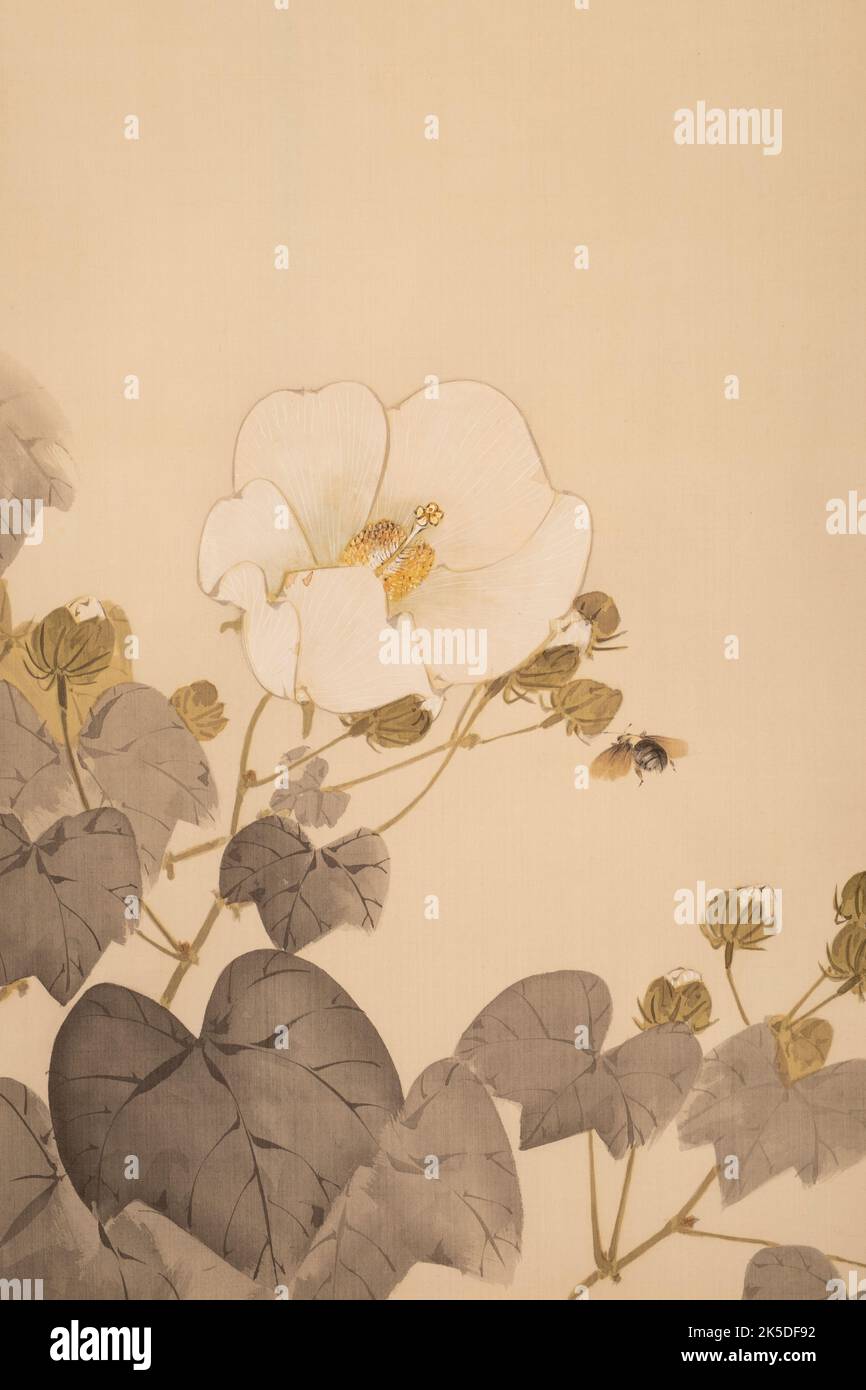 The Twelve Months: Eighth Month, between 1900 and 1918. Stock Photohttps://www.alamy.com/image-license-details/?v=1https://www.alamy.com/the-twelve-months-eighth-month-between-1900-and-1918-image485260974.html
The Twelve Months: Eighth Month, between 1900 and 1918. Stock Photohttps://www.alamy.com/image-license-details/?v=1https://www.alamy.com/the-twelve-months-eighth-month-between-1900-and-1918-image485260974.htmlRM2K5DF92–The Twelve Months: Eighth Month, between 1900 and 1918.
 The Twelve Months: Third Month, between 1900 and 1918. Stock Photohttps://www.alamy.com/image-license-details/?v=1https://www.alamy.com/the-twelve-months-third-month-between-1900-and-1918-image485260823.html
The Twelve Months: Third Month, between 1900 and 1918. Stock Photohttps://www.alamy.com/image-license-details/?v=1https://www.alamy.com/the-twelve-months-third-month-between-1900-and-1918-image485260823.htmlRM2K5DF3K–The Twelve Months: Third Month, between 1900 and 1918.
 The Twelve Months: Ninth Month, between 1900 and 1918. Stock Photohttps://www.alamy.com/image-license-details/?v=1https://www.alamy.com/the-twelve-months-ninth-month-between-1900-and-1918-image485261063.html
The Twelve Months: Ninth Month, between 1900 and 1918. Stock Photohttps://www.alamy.com/image-license-details/?v=1https://www.alamy.com/the-twelve-months-ninth-month-between-1900-and-1918-image485261063.htmlRM2K5DFC7–The Twelve Months: Ninth Month, between 1900 and 1918.
 The Twelve Months, between 1900 and 1918. Stock Photohttps://www.alamy.com/image-license-details/?v=1https://www.alamy.com/the-twelve-months-between-1900-and-1918-image485261278.html
The Twelve Months, between 1900 and 1918. Stock Photohttps://www.alamy.com/image-license-details/?v=1https://www.alamy.com/the-twelve-months-between-1900-and-1918-image485261278.htmlRM2K5DFKX–The Twelve Months, between 1900 and 1918.
 The Twelve Months: Eighth Month, between 1900 and 1918. Stock Photohttps://www.alamy.com/image-license-details/?v=1https://www.alamy.com/the-twelve-months-eighth-month-between-1900-and-1918-image485260971.html
The Twelve Months: Eighth Month, between 1900 and 1918. Stock Photohttps://www.alamy.com/image-license-details/?v=1https://www.alamy.com/the-twelve-months-eighth-month-between-1900-and-1918-image485260971.htmlRM2K5DF8Y–The Twelve Months: Eighth Month, between 1900 and 1918.
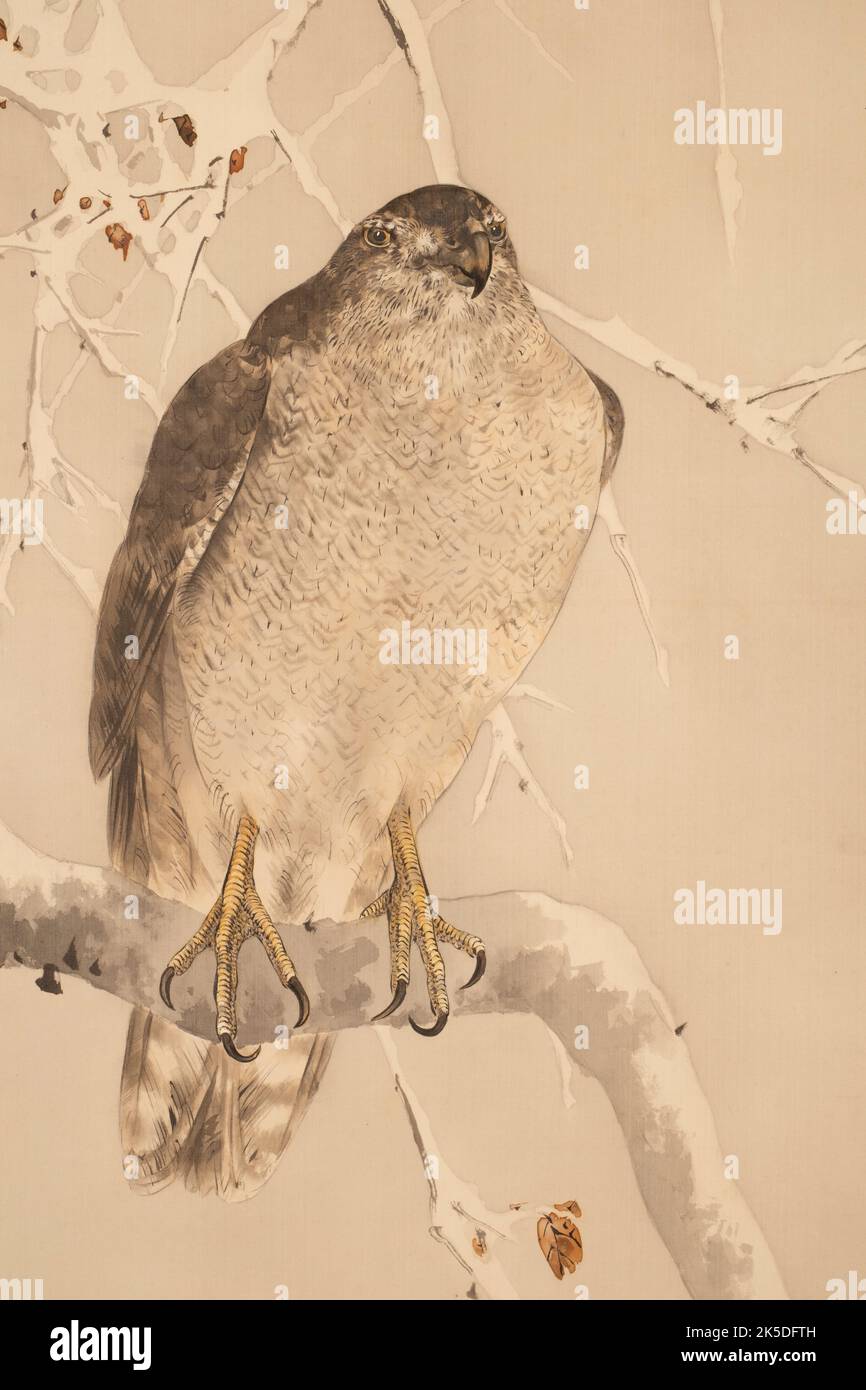 The twelve months: twelfth month, between 1900 and 1918. Stock Photohttps://www.alamy.com/image-license-details/?v=1https://www.alamy.com/the-twelve-months-twelfth-month-between-1900-and-1918-image485261409.html
The twelve months: twelfth month, between 1900 and 1918. Stock Photohttps://www.alamy.com/image-license-details/?v=1https://www.alamy.com/the-twelve-months-twelfth-month-between-1900-and-1918-image485261409.htmlRM2K5DFTH–The twelve months: twelfth month, between 1900 and 1918.
 The Twelve Months, between 1900 and 1918. Stock Photohttps://www.alamy.com/image-license-details/?v=1https://www.alamy.com/the-twelve-months-between-1900-and-1918-image485261179.html
The Twelve Months, between 1900 and 1918. Stock Photohttps://www.alamy.com/image-license-details/?v=1https://www.alamy.com/the-twelve-months-between-1900-and-1918-image485261179.htmlRM2K5DFGB–The Twelve Months, between 1900 and 1918.
 The Twelve Months: Third Month, between 1900 and 1918. Stock Photohttps://www.alamy.com/image-license-details/?v=1https://www.alamy.com/the-twelve-months-third-month-between-1900-and-1918-image485260753.html
The Twelve Months: Third Month, between 1900 and 1918. Stock Photohttps://www.alamy.com/image-license-details/?v=1https://www.alamy.com/the-twelve-months-third-month-between-1900-and-1918-image485260753.htmlRM2K5DF15–The Twelve Months: Third Month, between 1900 and 1918.
 The Twelve Months: Third Month, between 1900 and 1918. Stock Photohttps://www.alamy.com/image-license-details/?v=1https://www.alamy.com/the-twelve-months-third-month-between-1900-and-1918-image485260768.html
The Twelve Months: Third Month, between 1900 and 1918. Stock Photohttps://www.alamy.com/image-license-details/?v=1https://www.alamy.com/the-twelve-months-third-month-between-1900-and-1918-image485260768.htmlRM2K5DF1M–The Twelve Months: Third Month, between 1900 and 1918.

